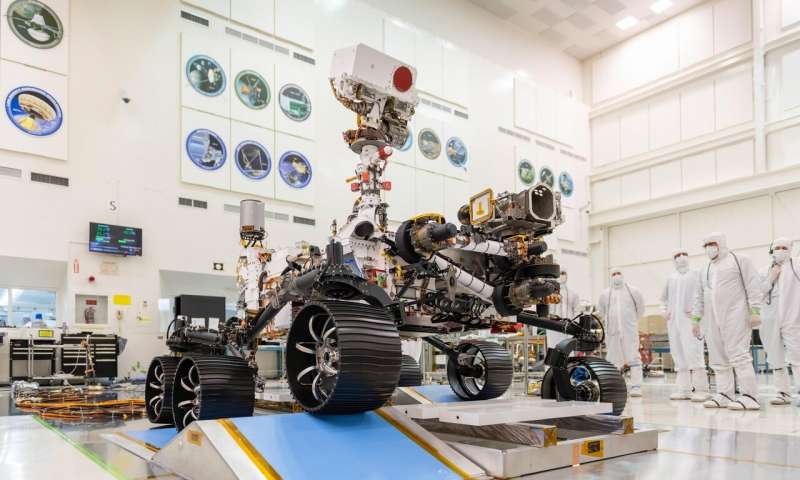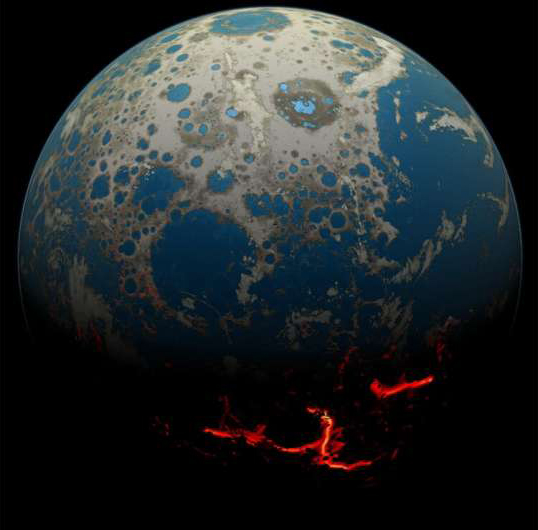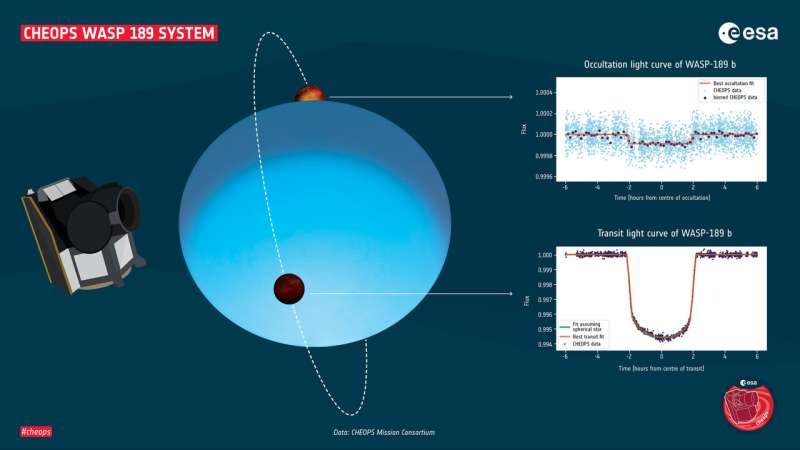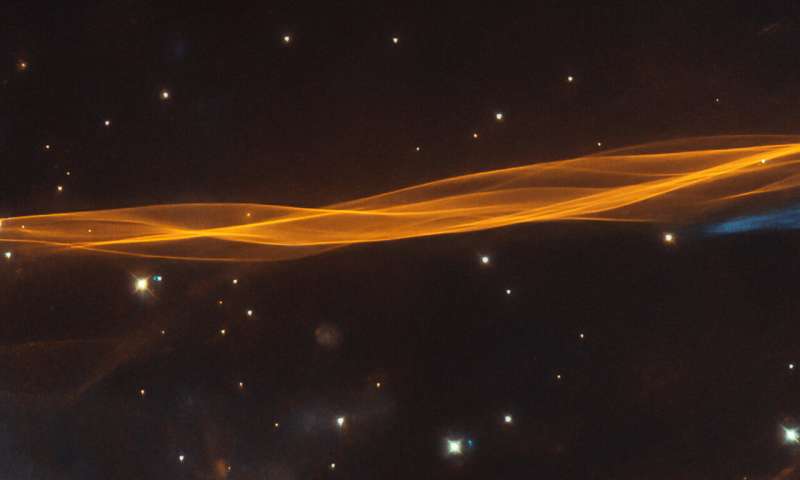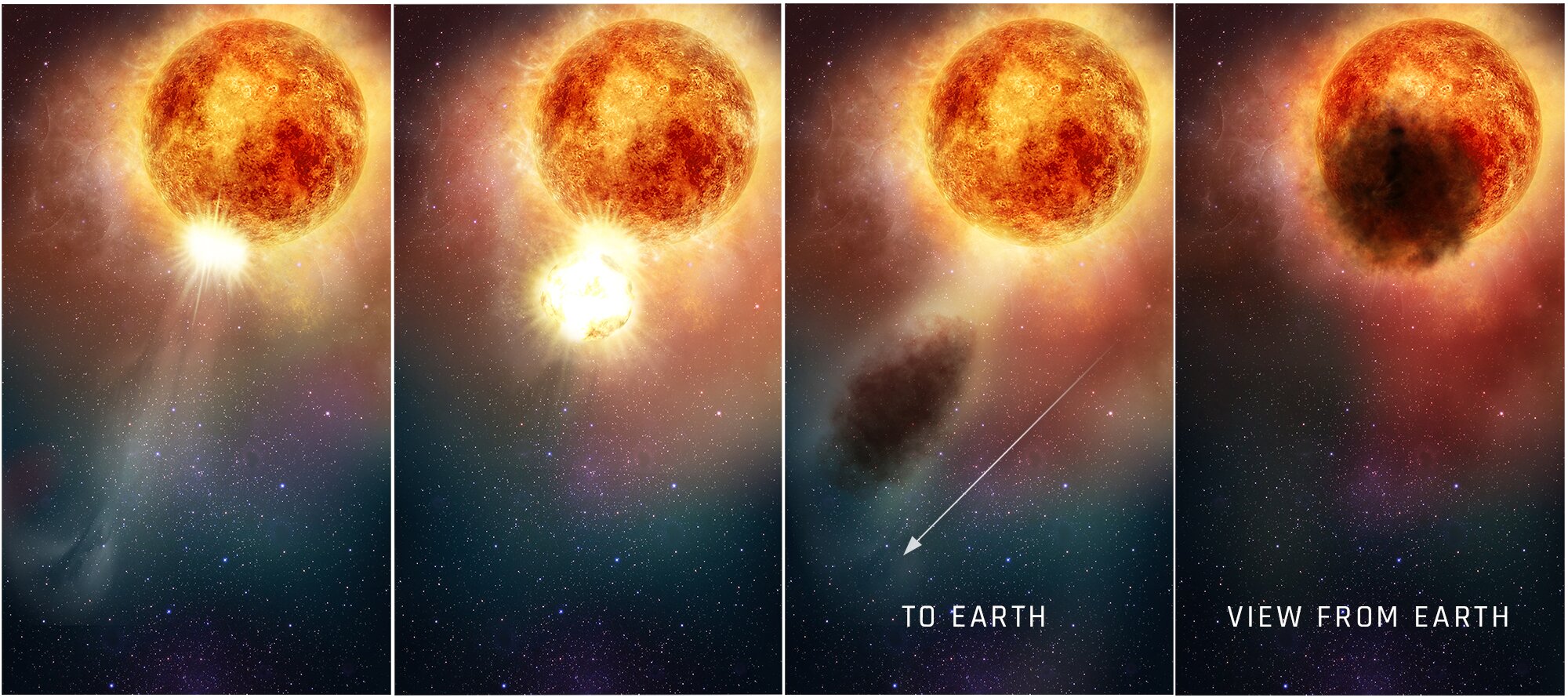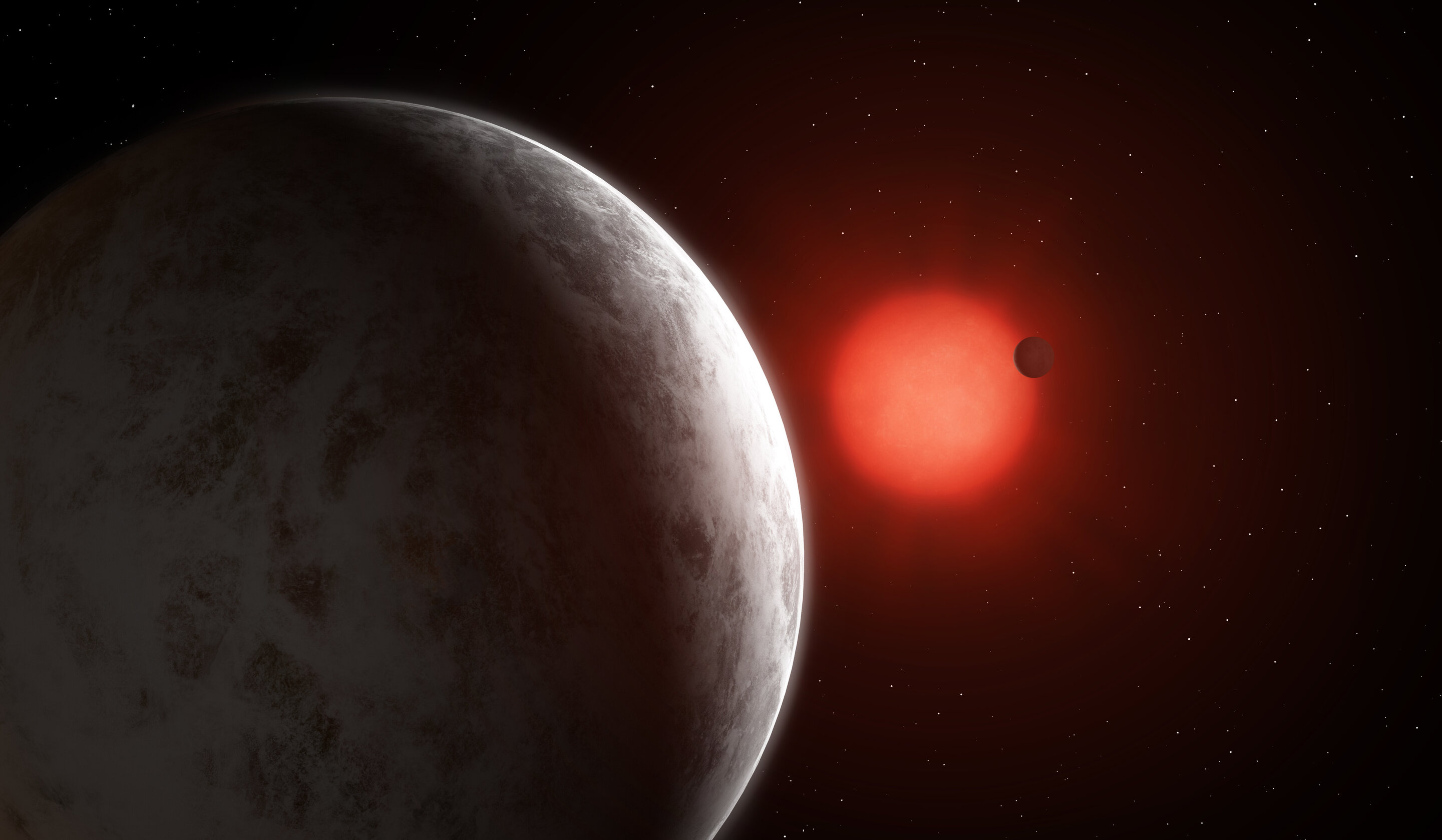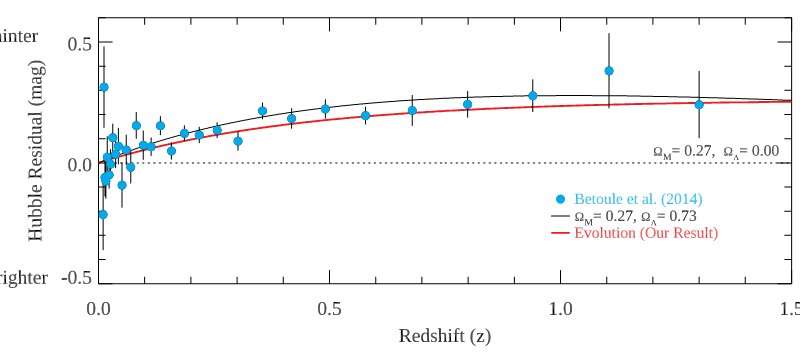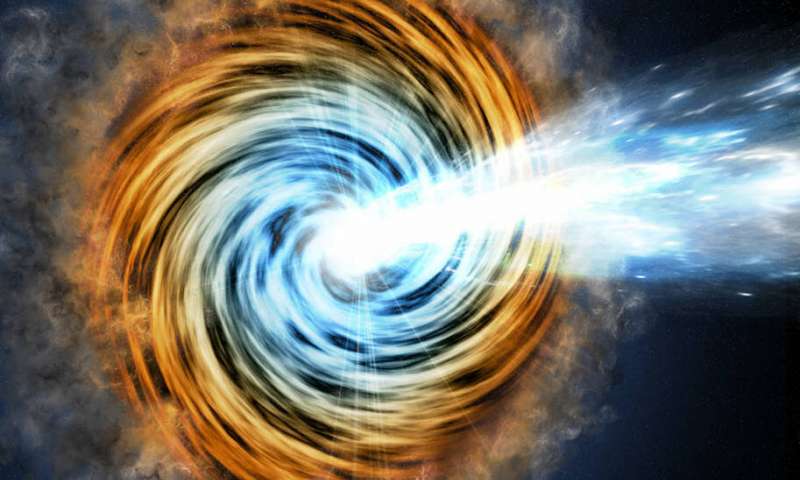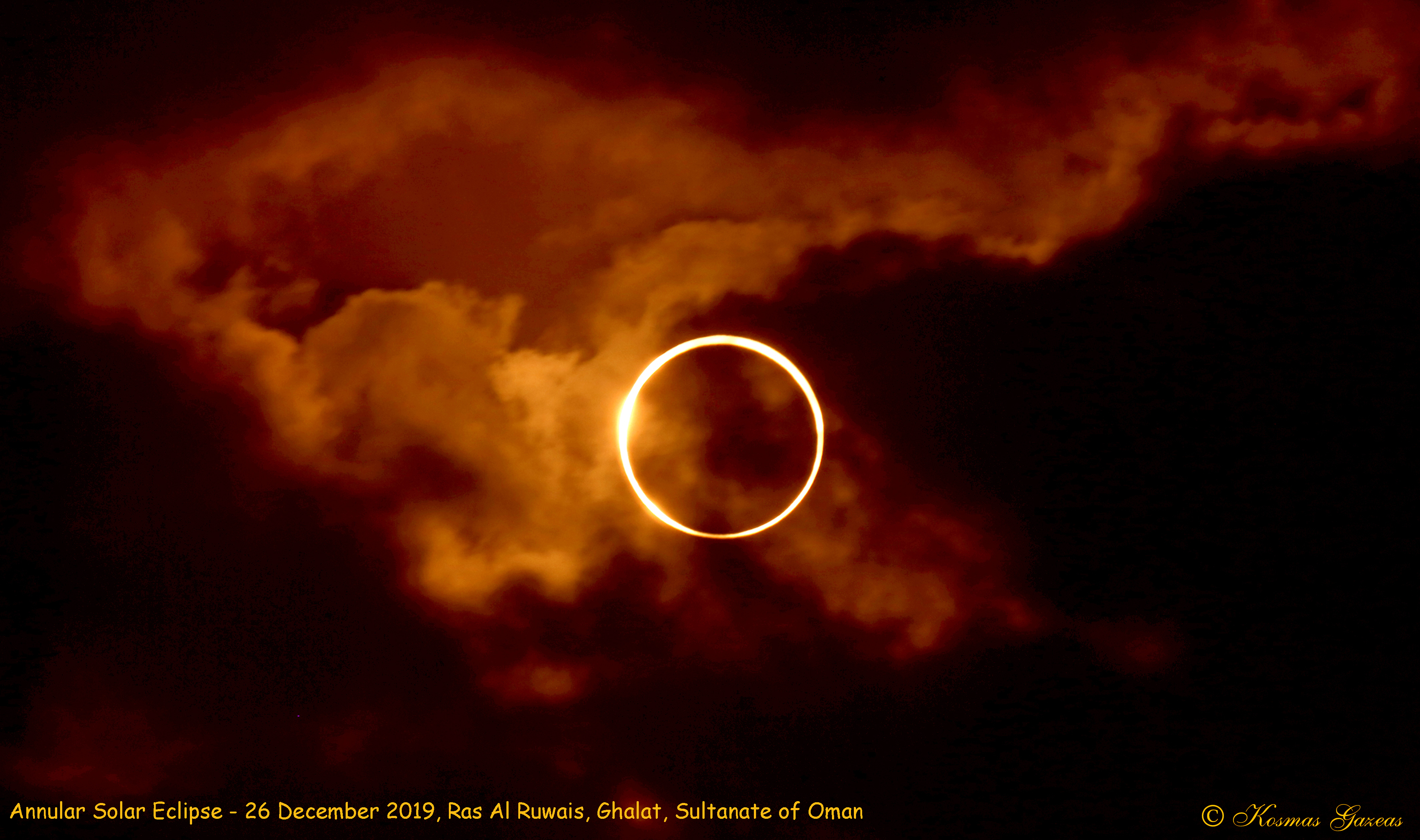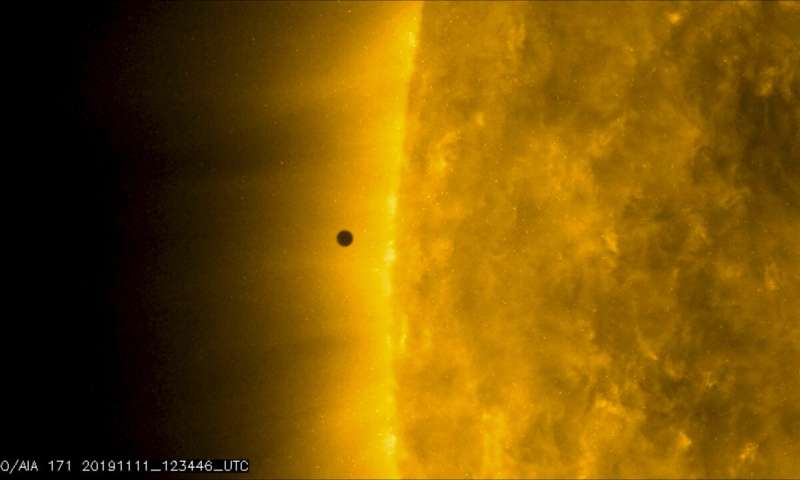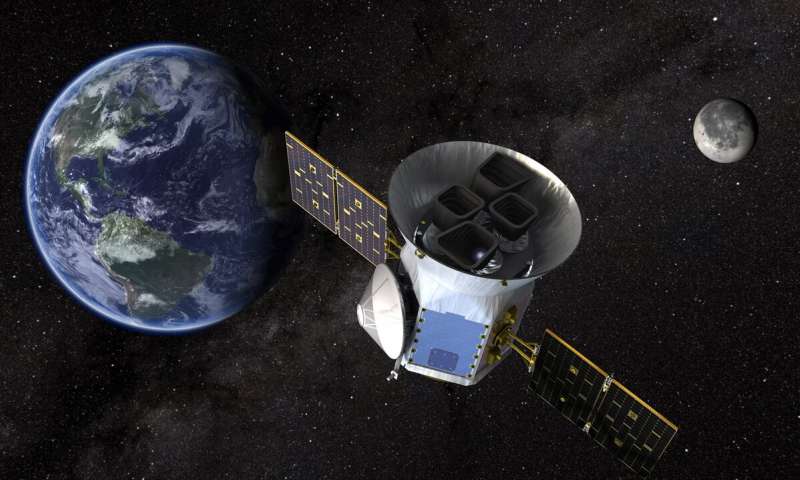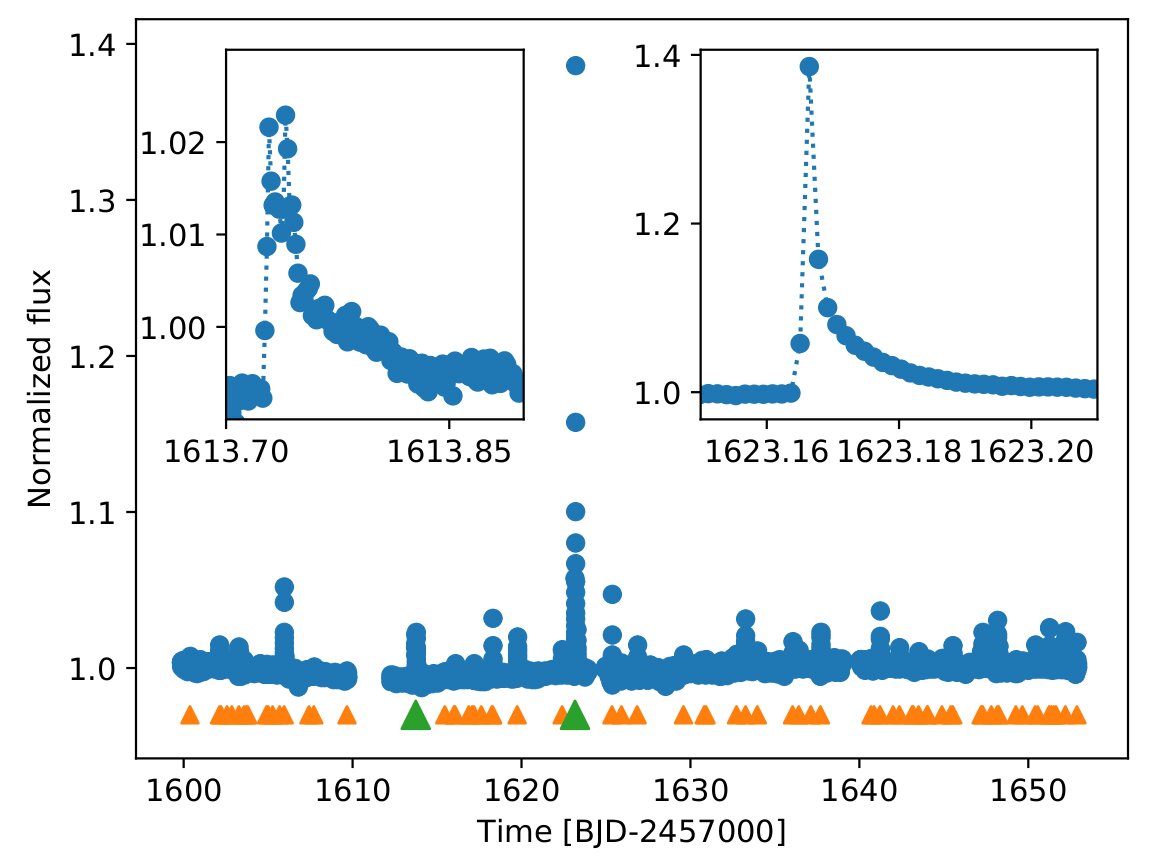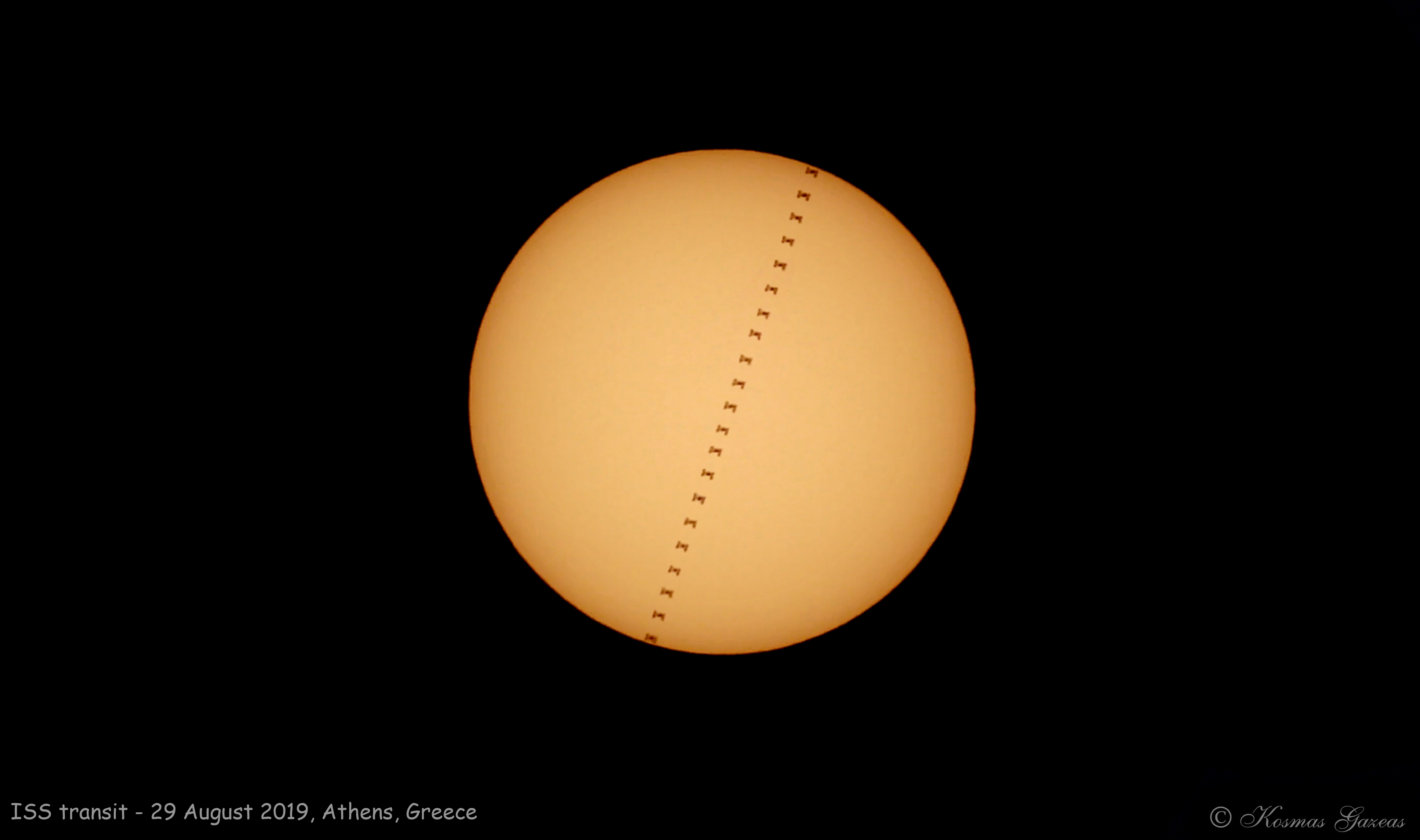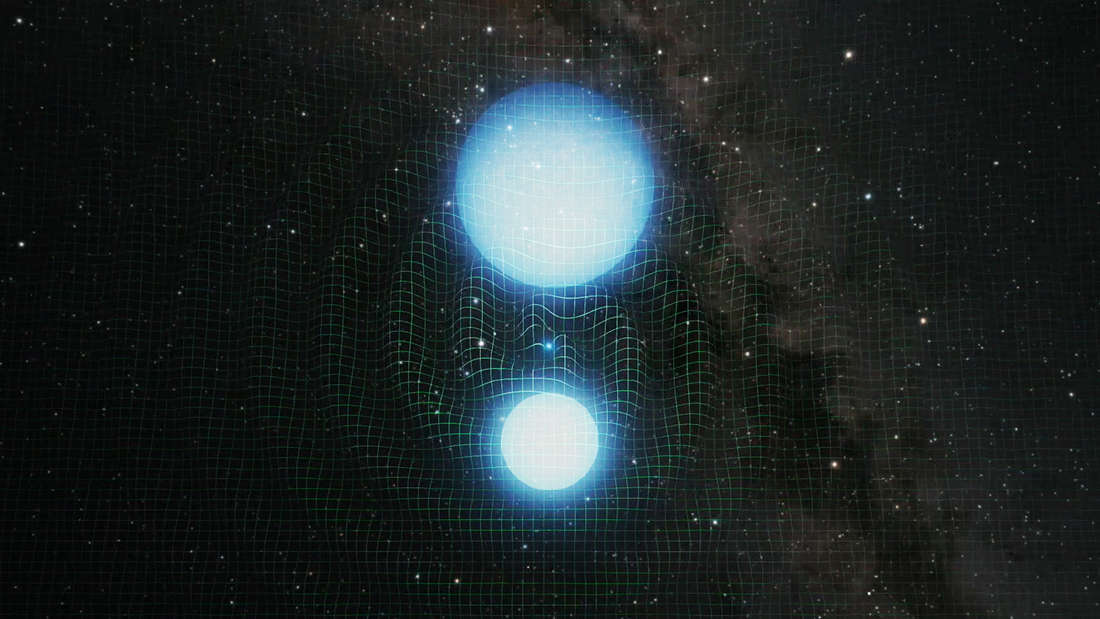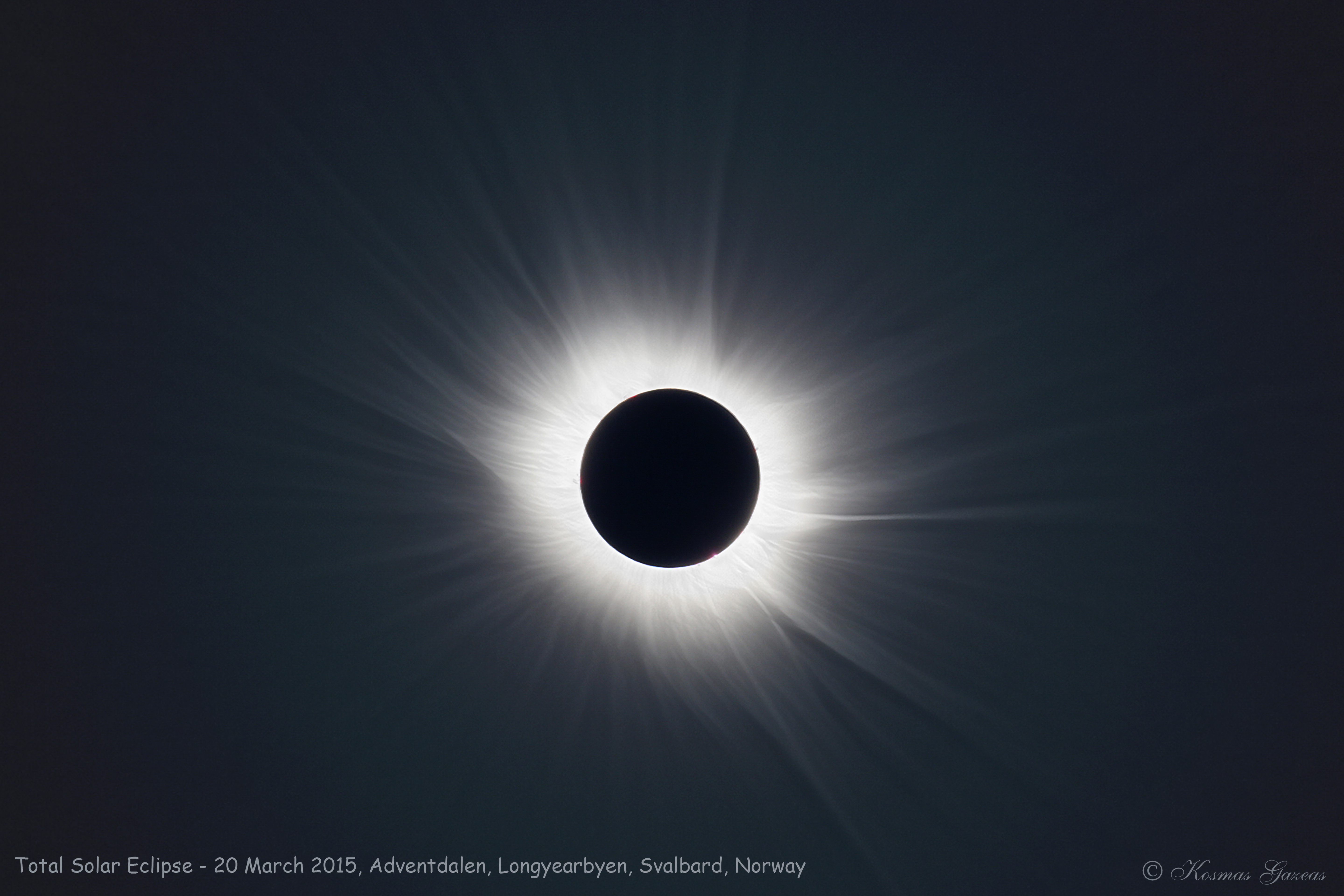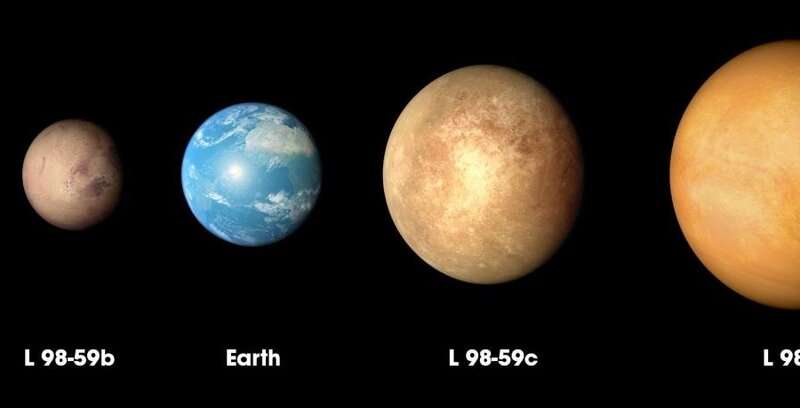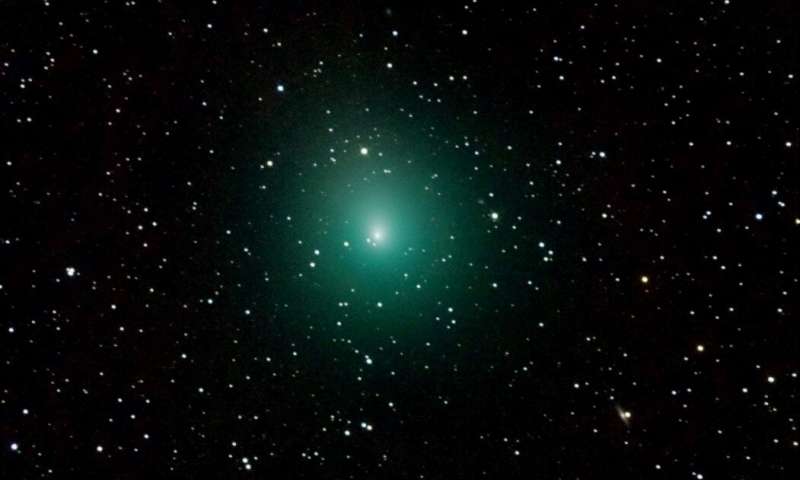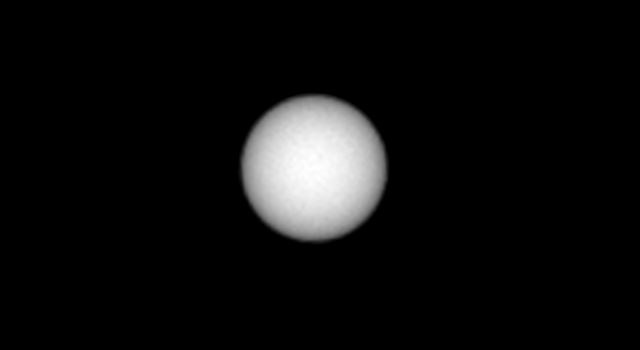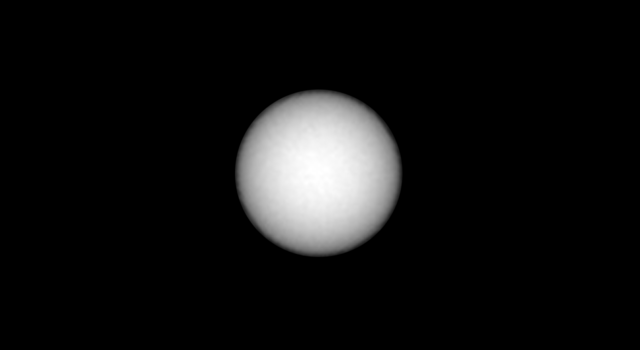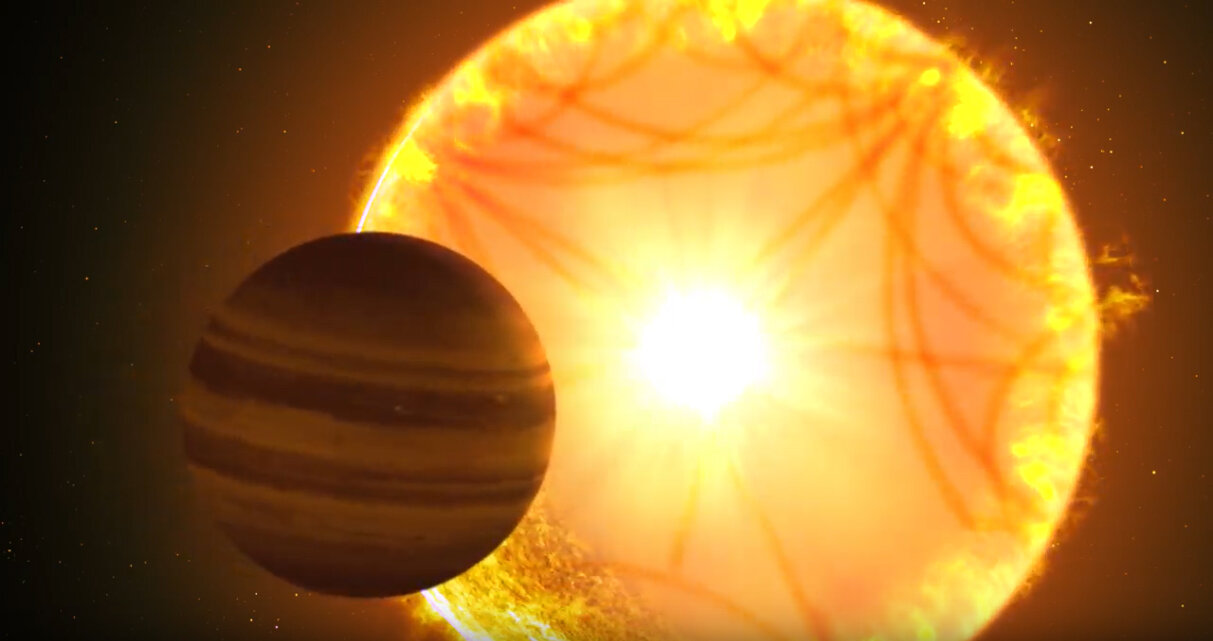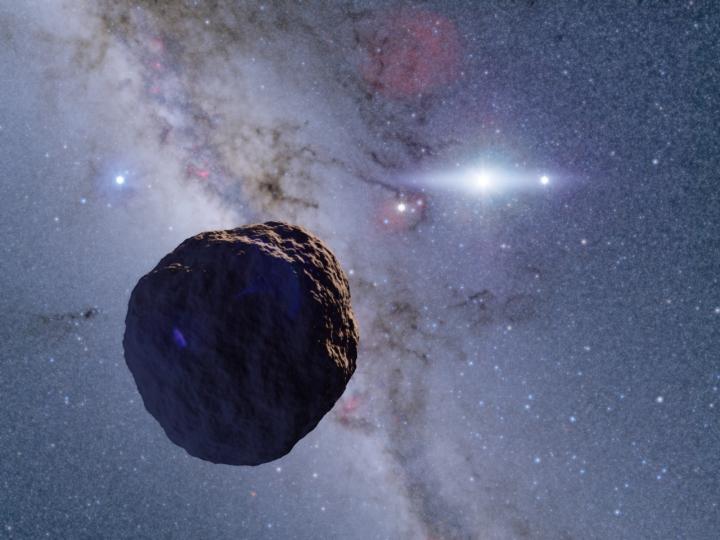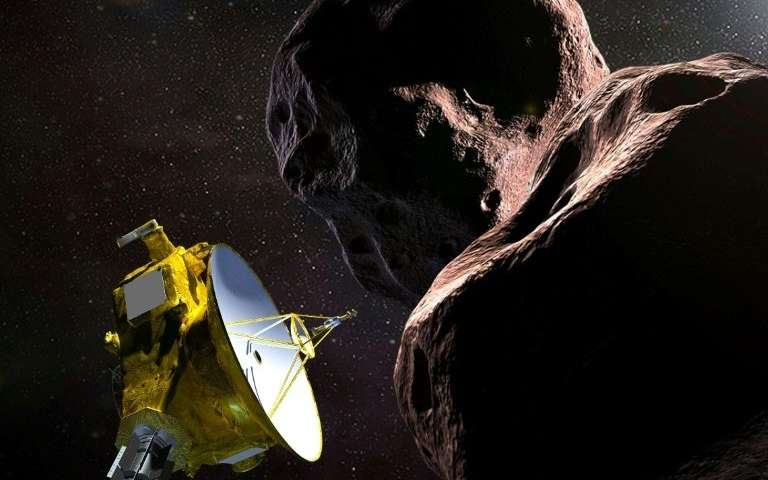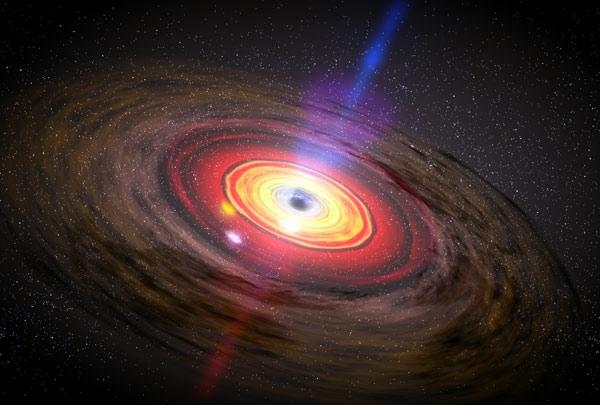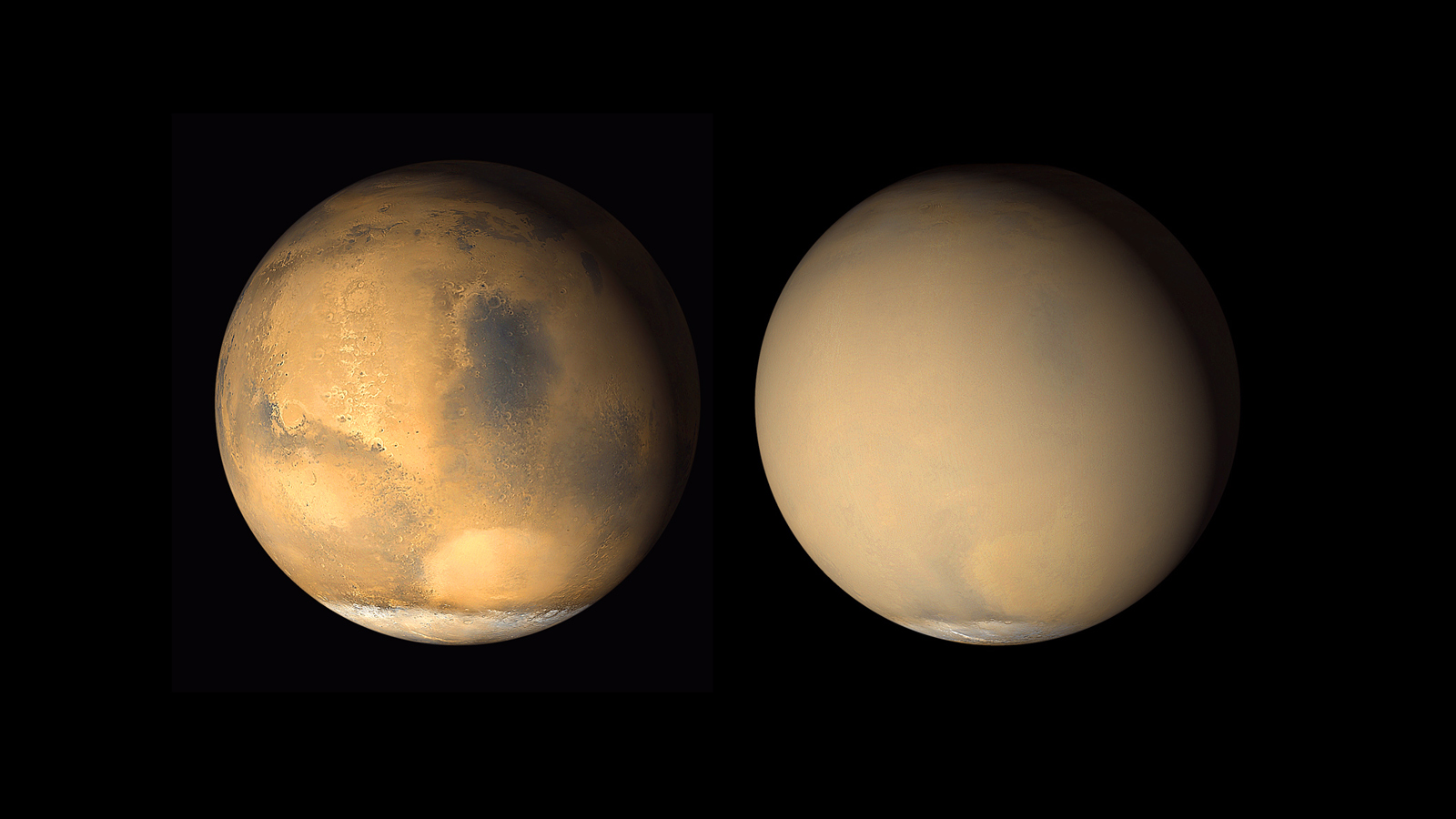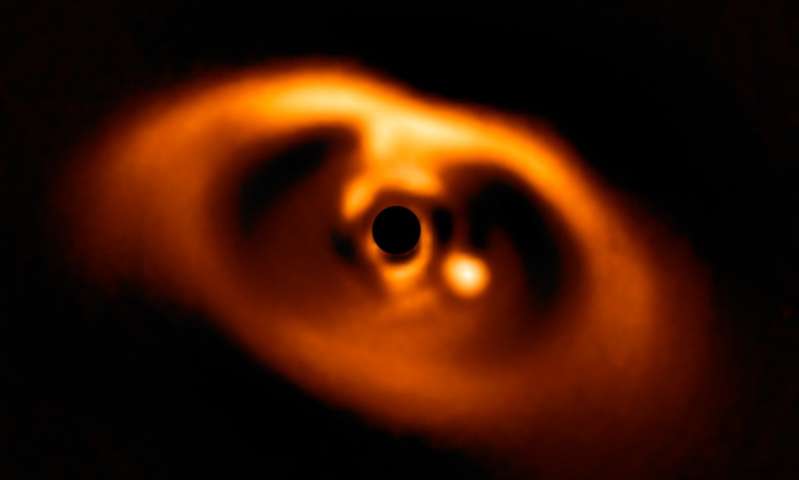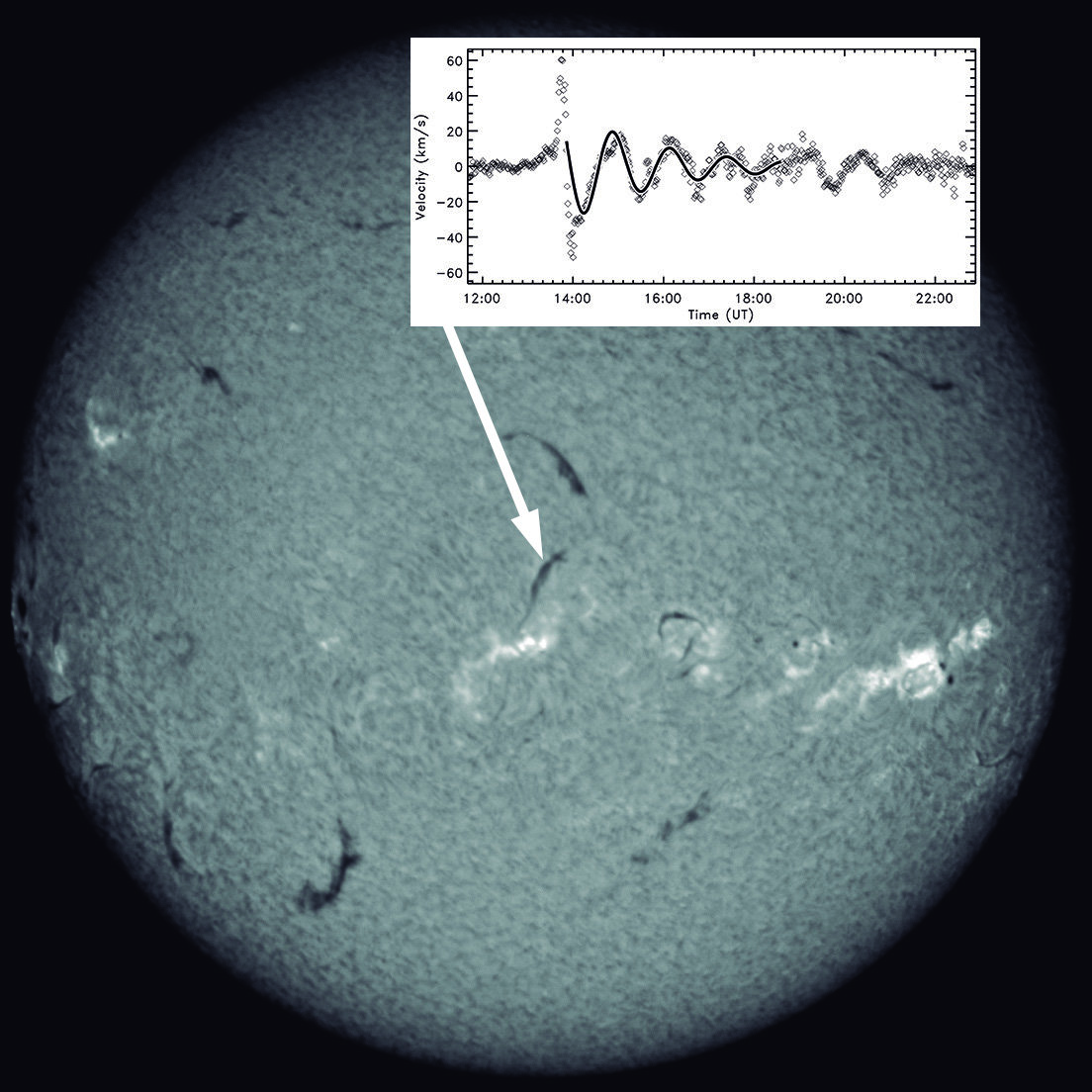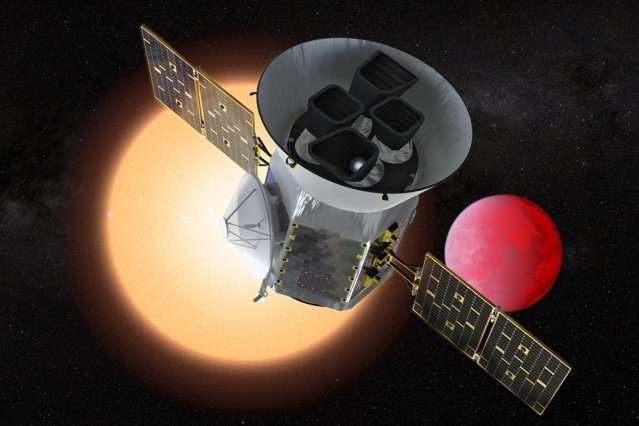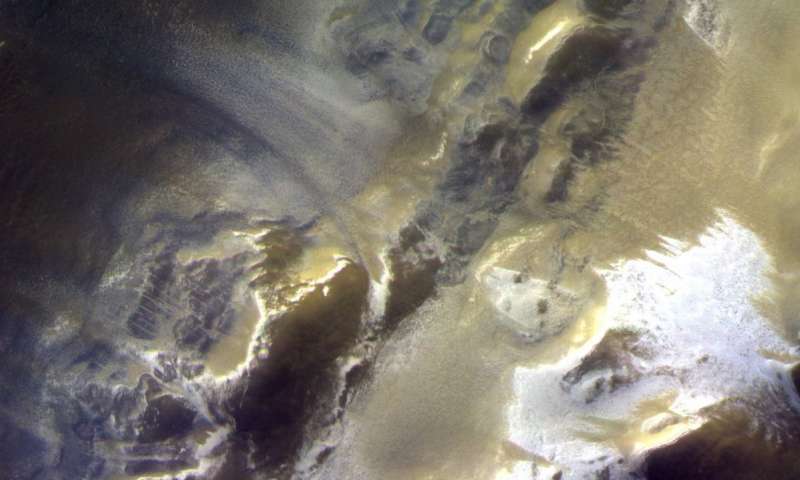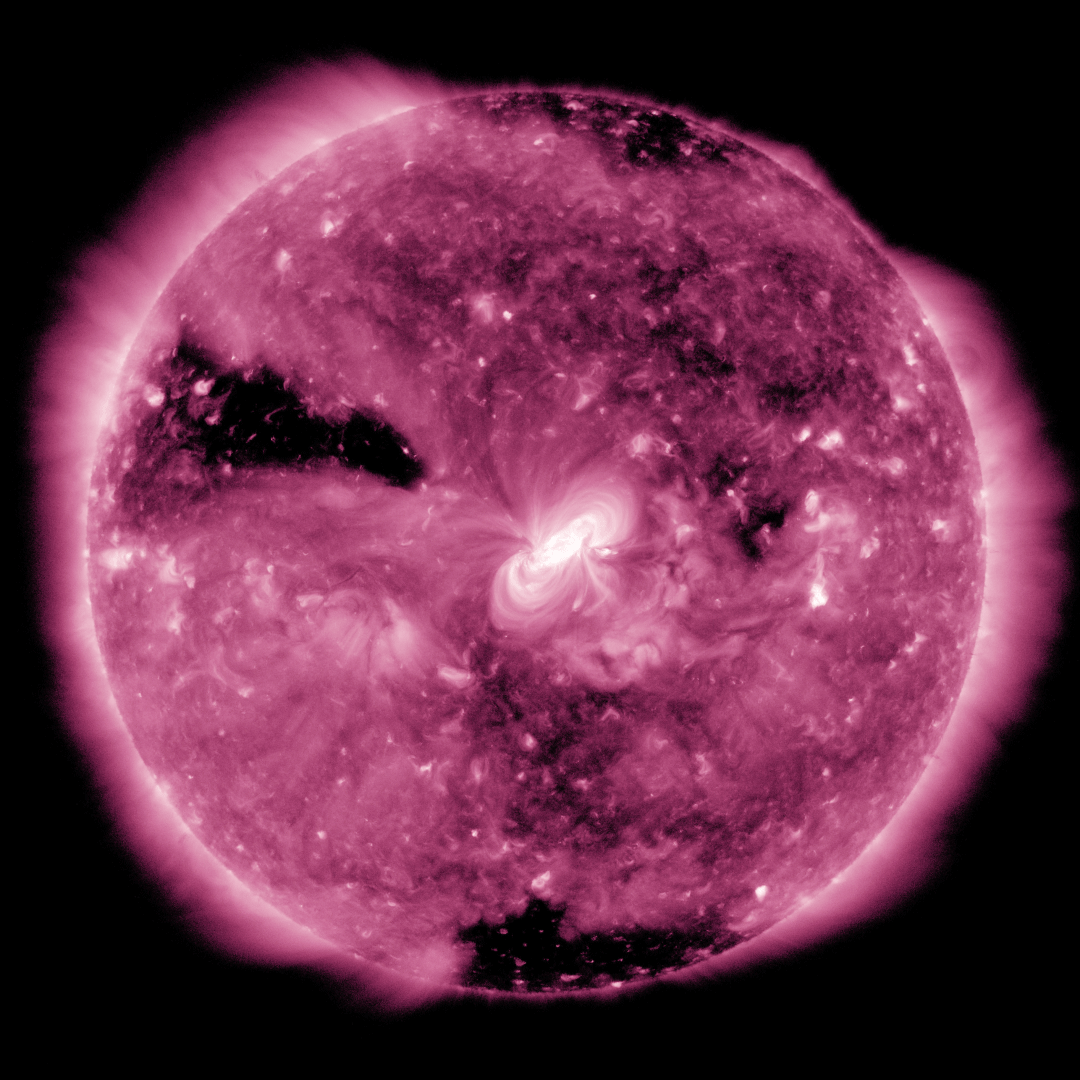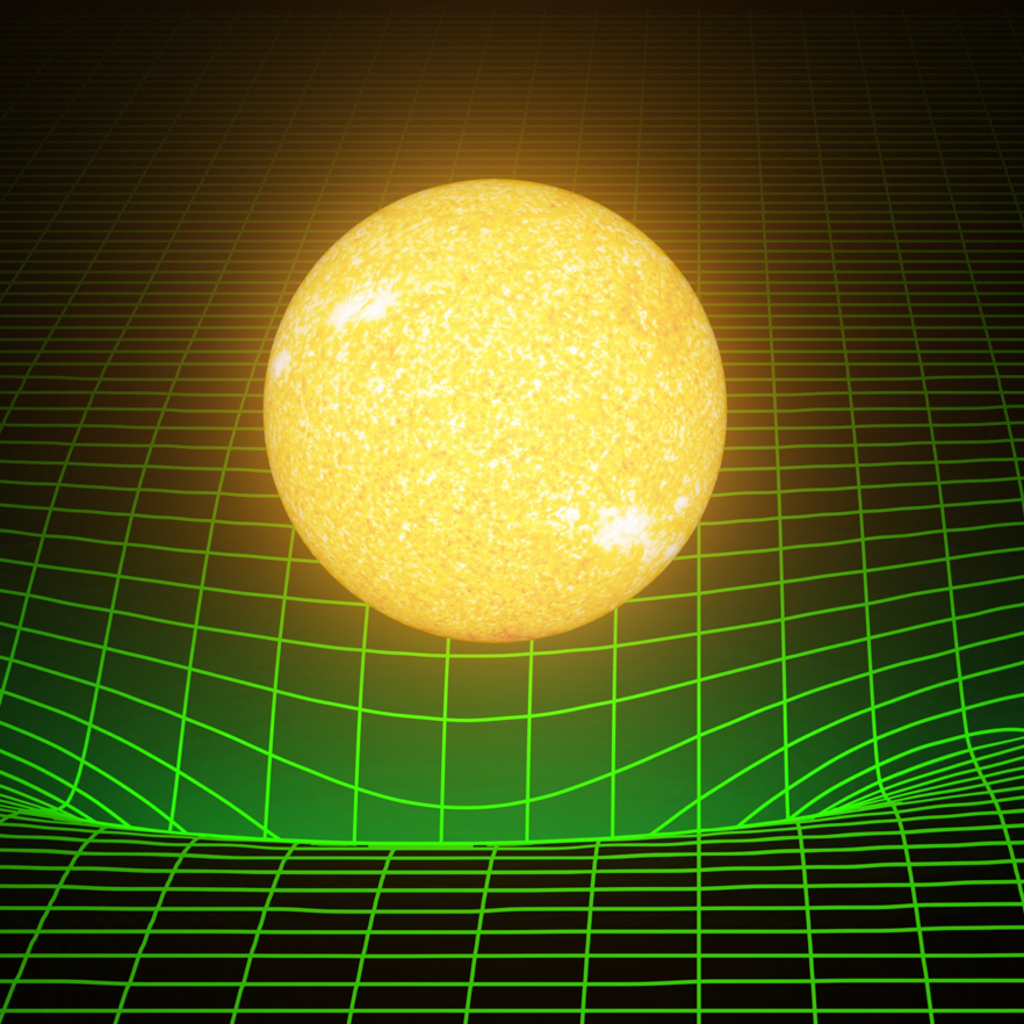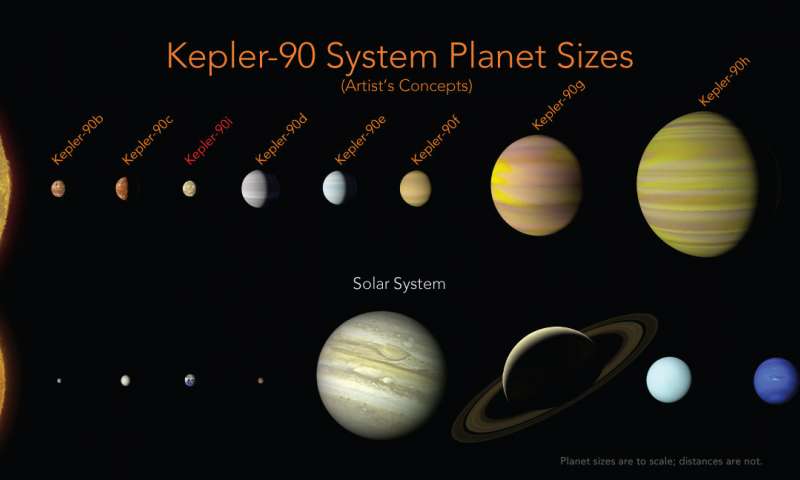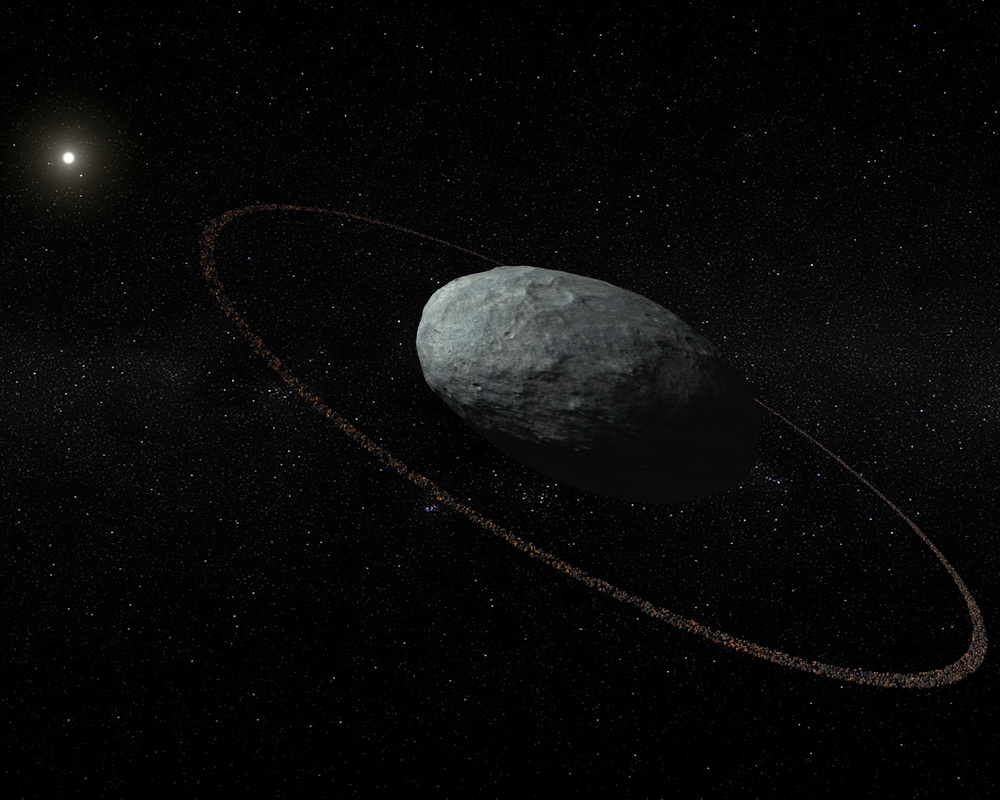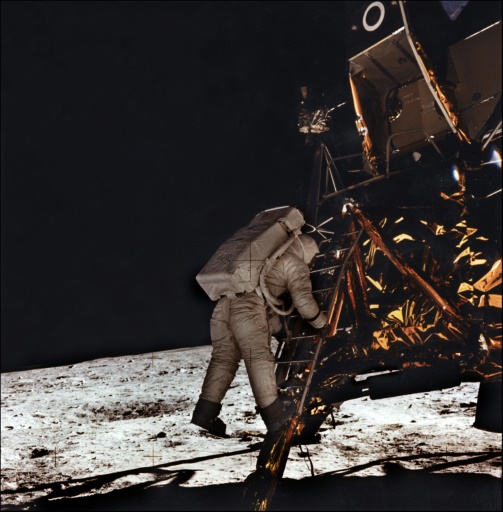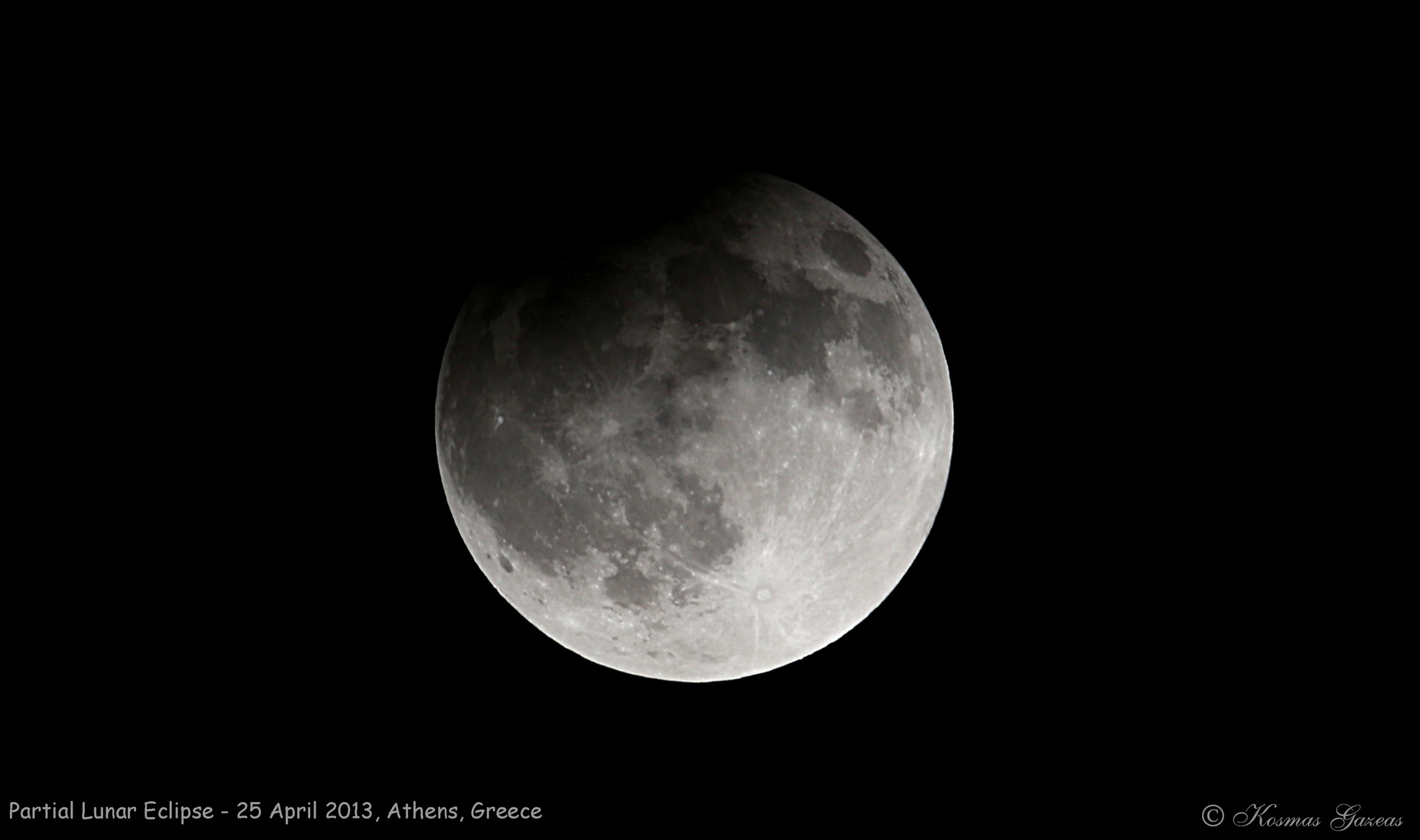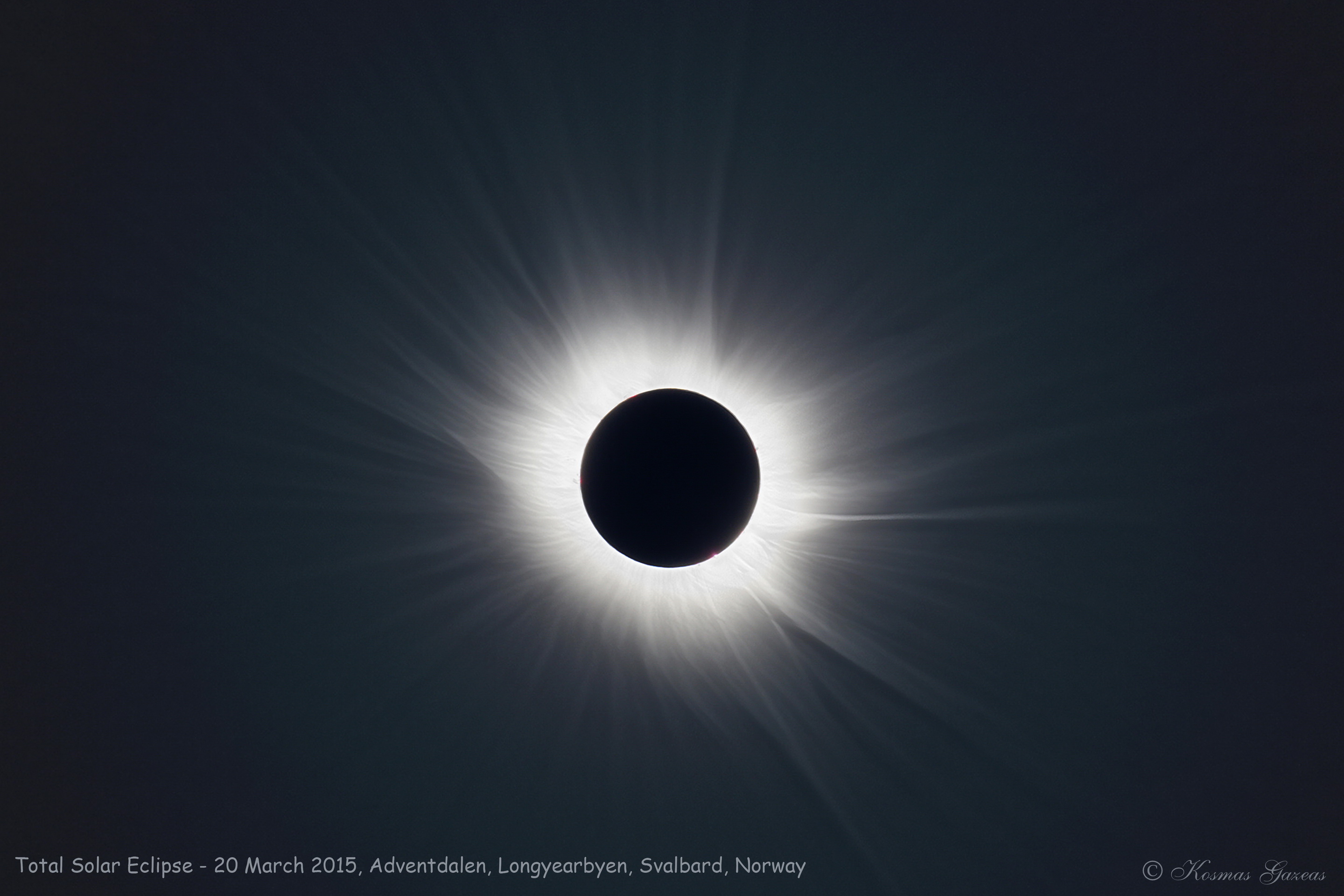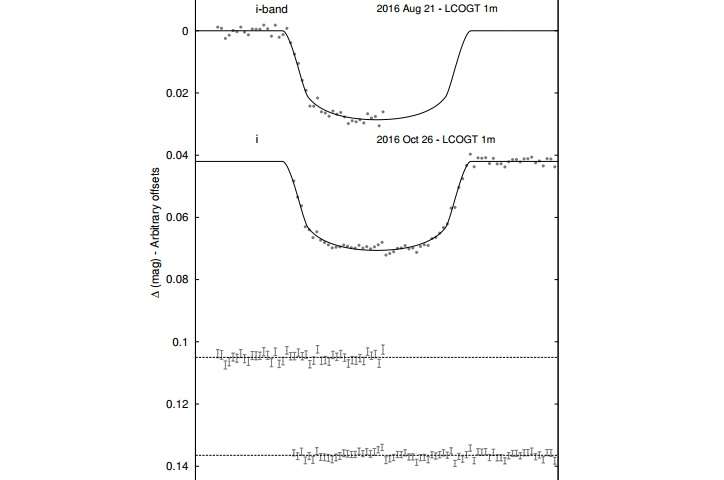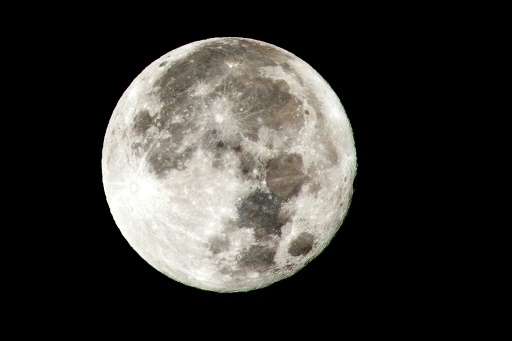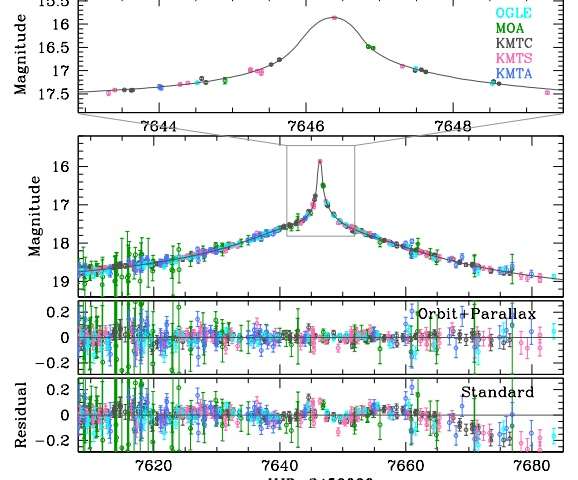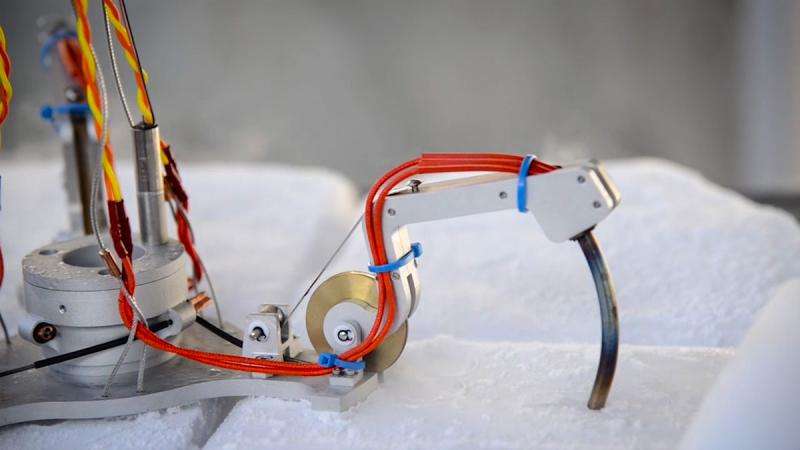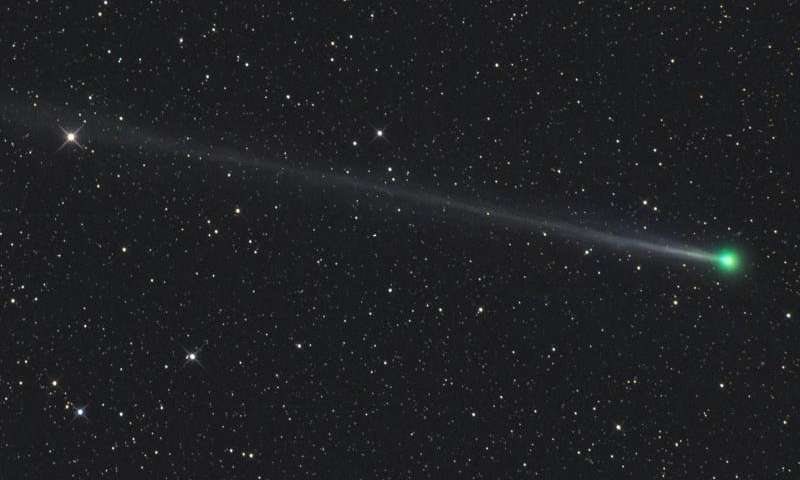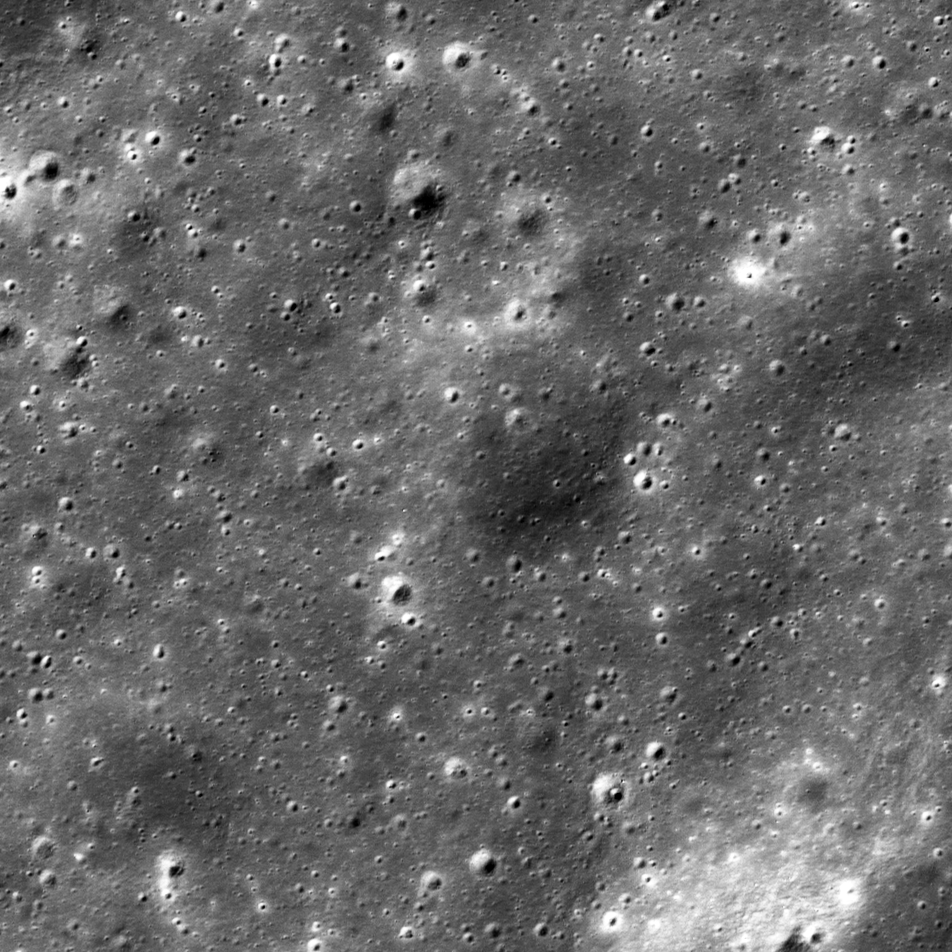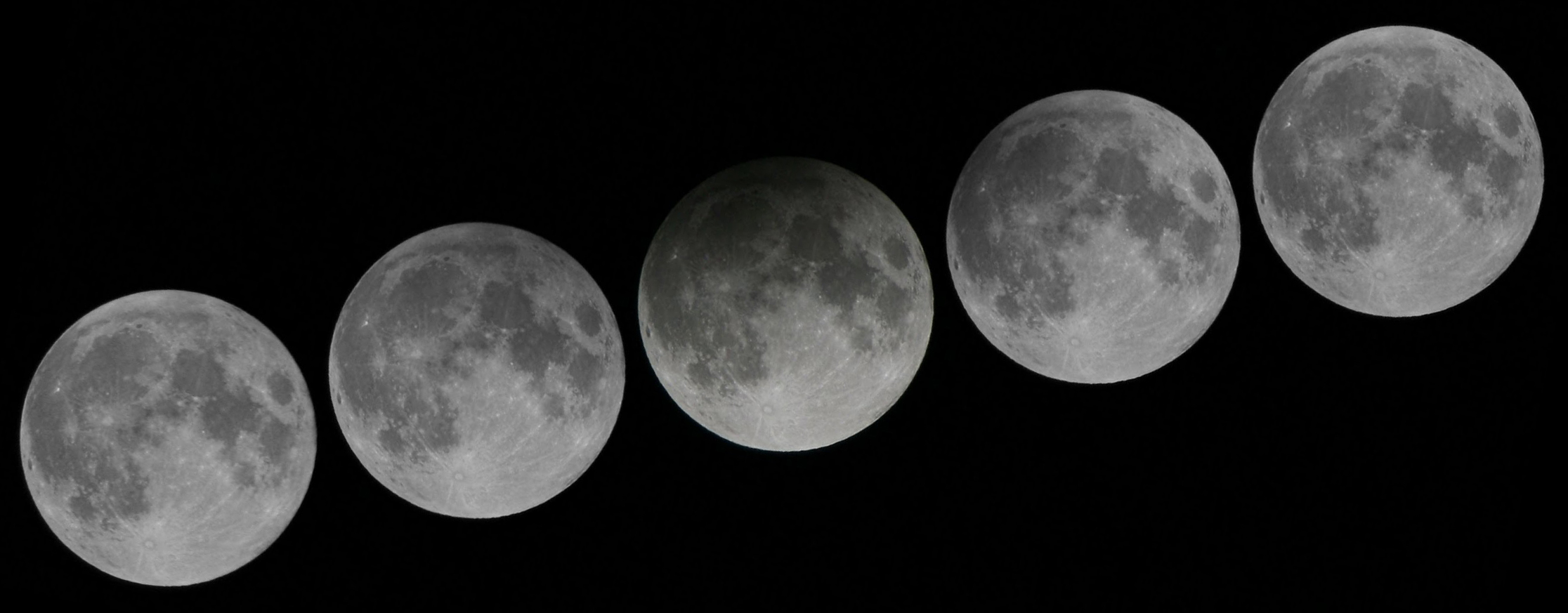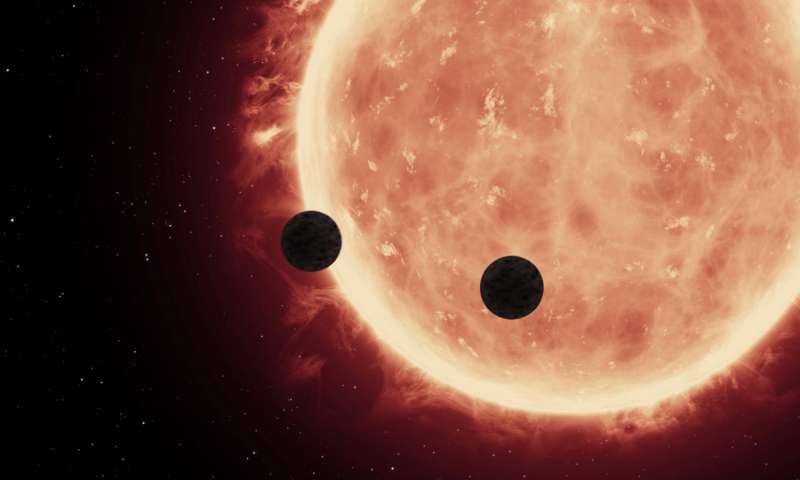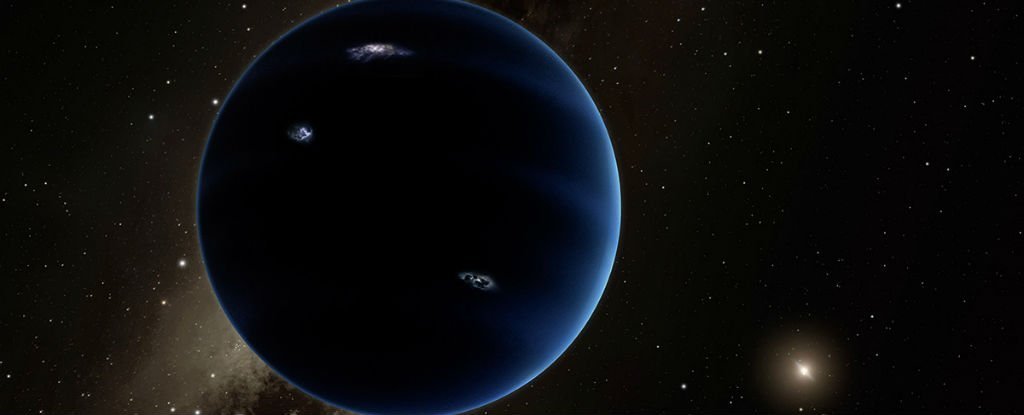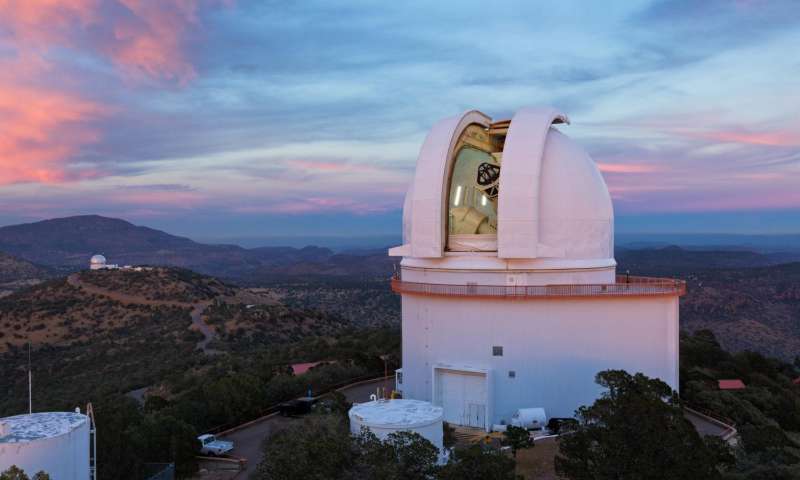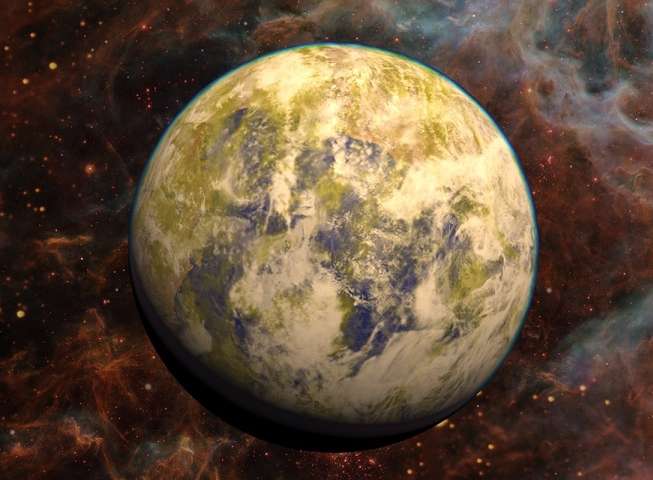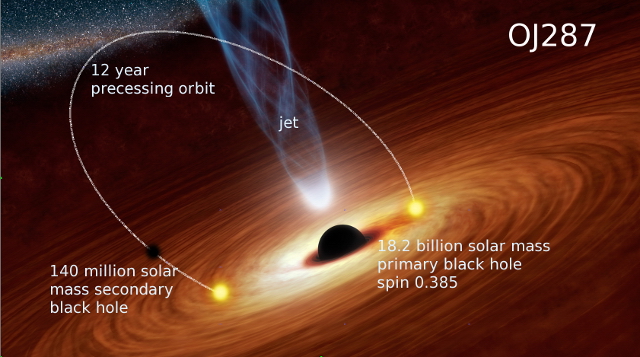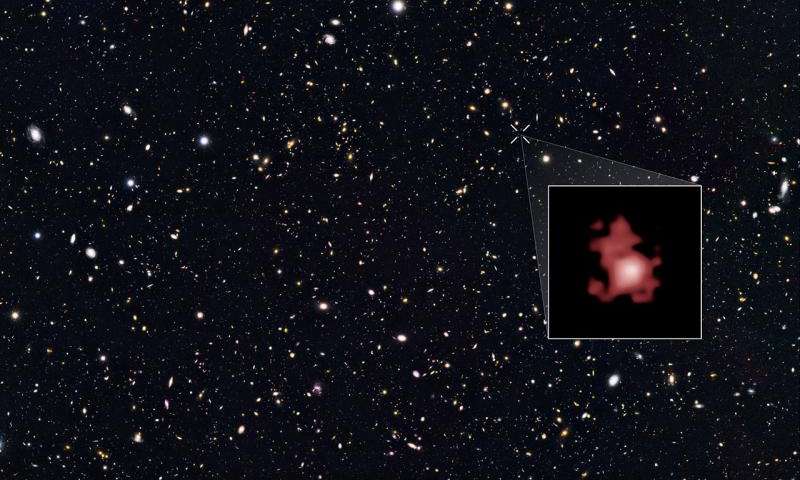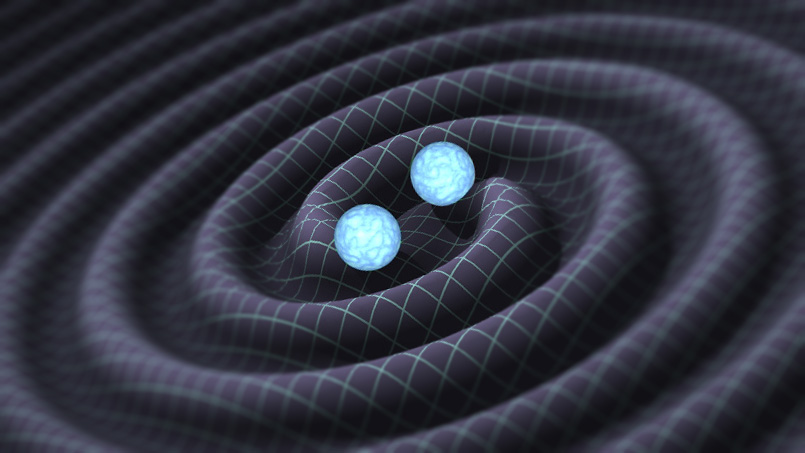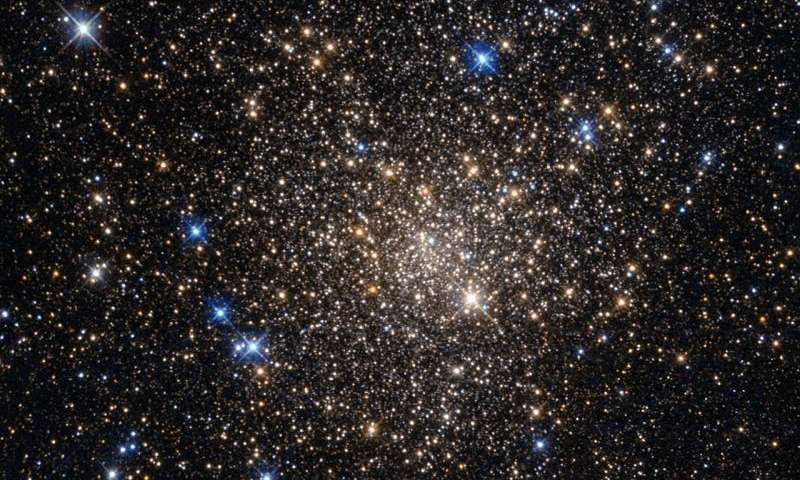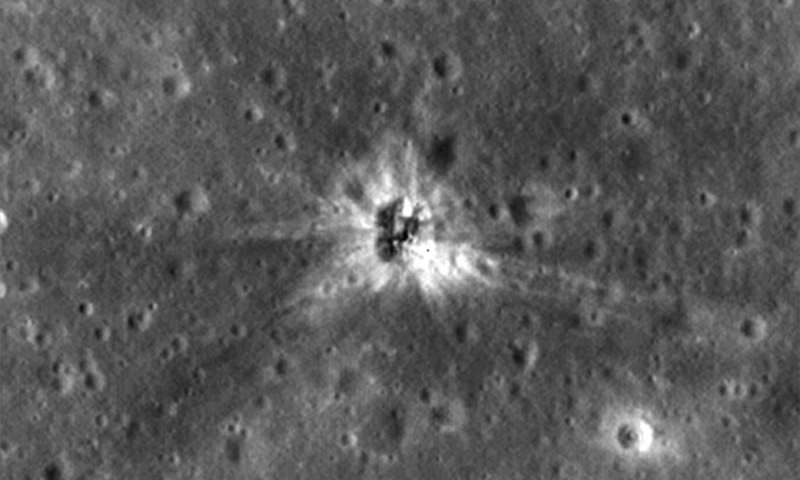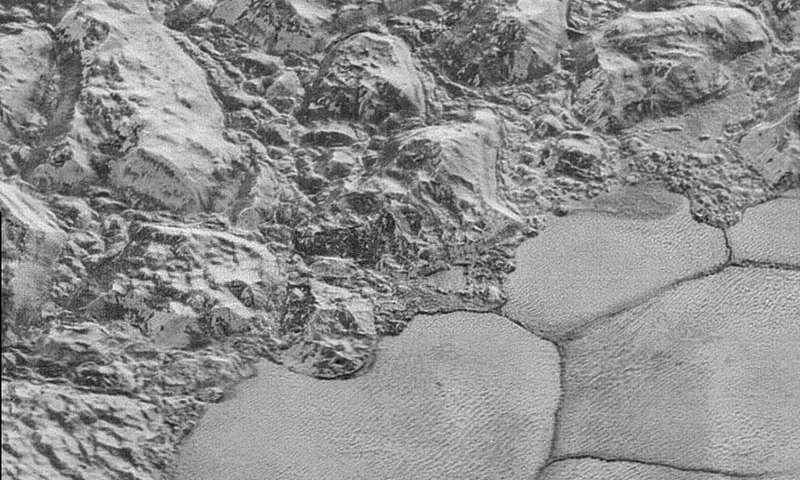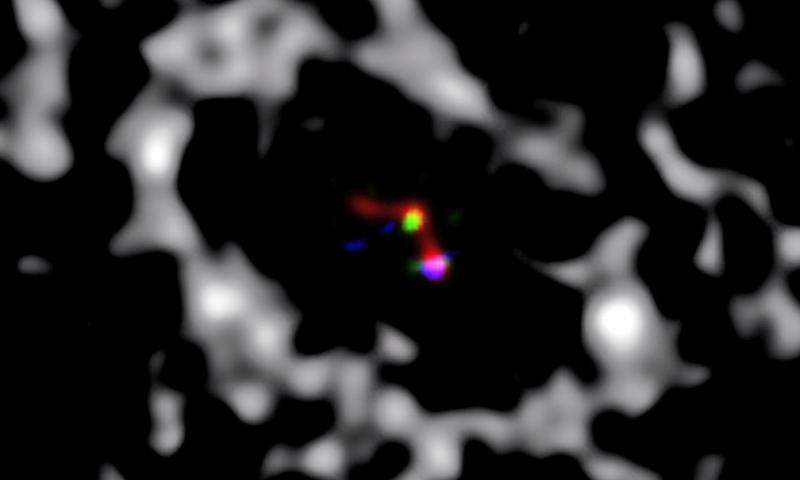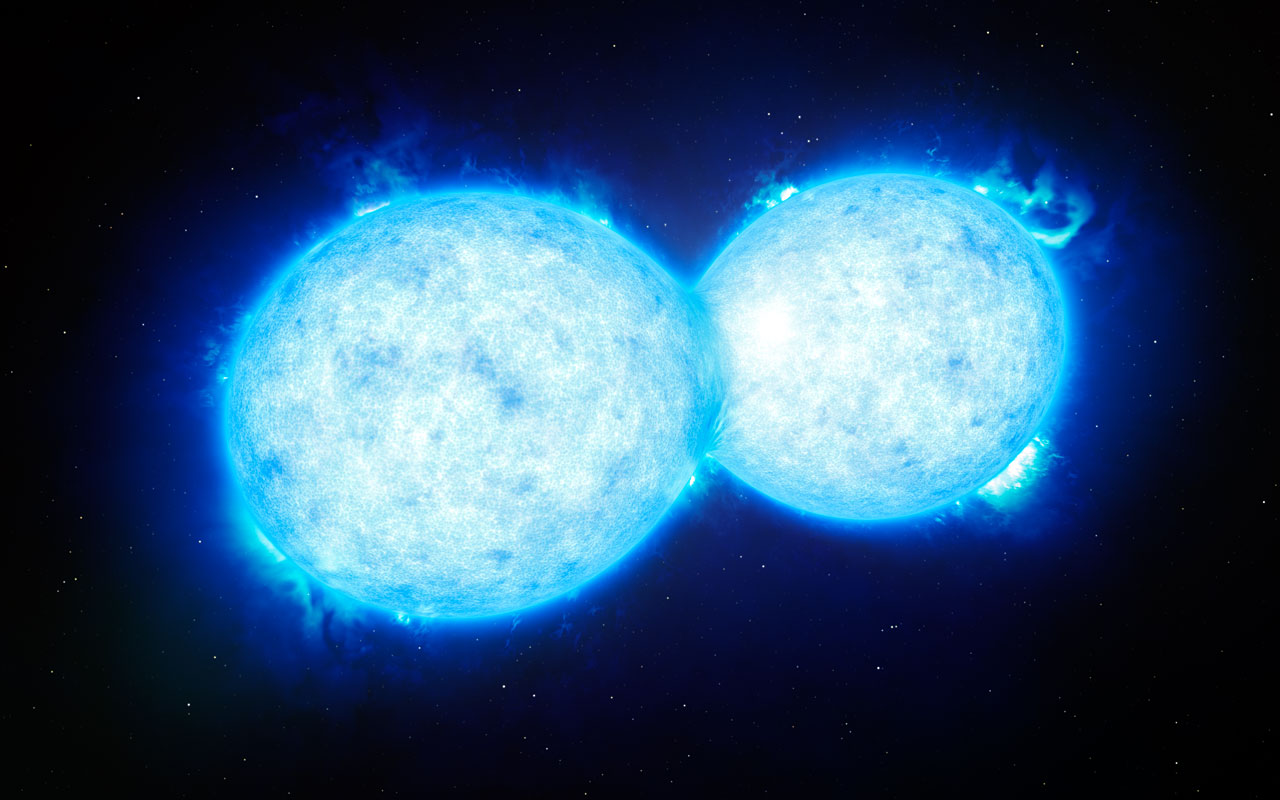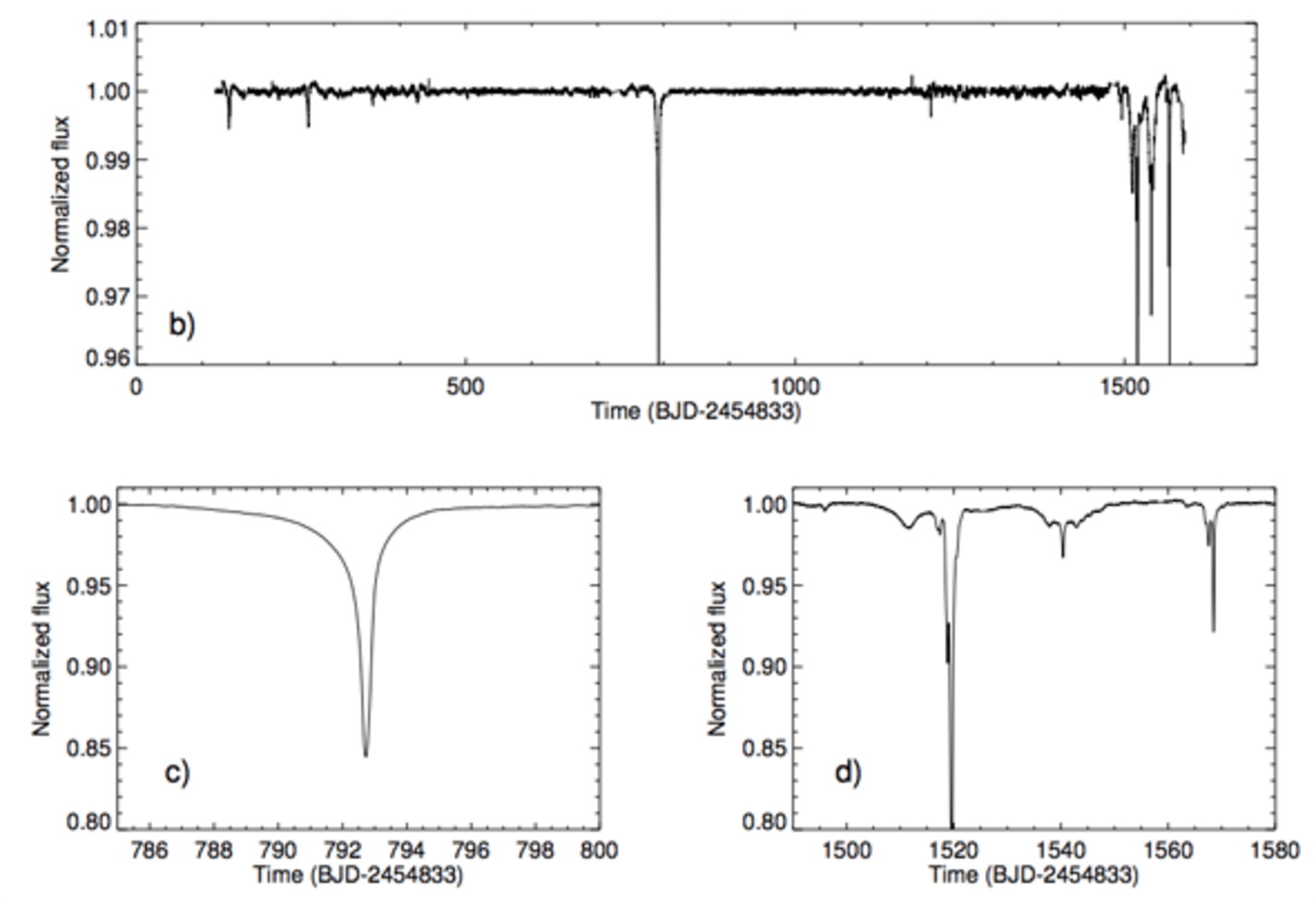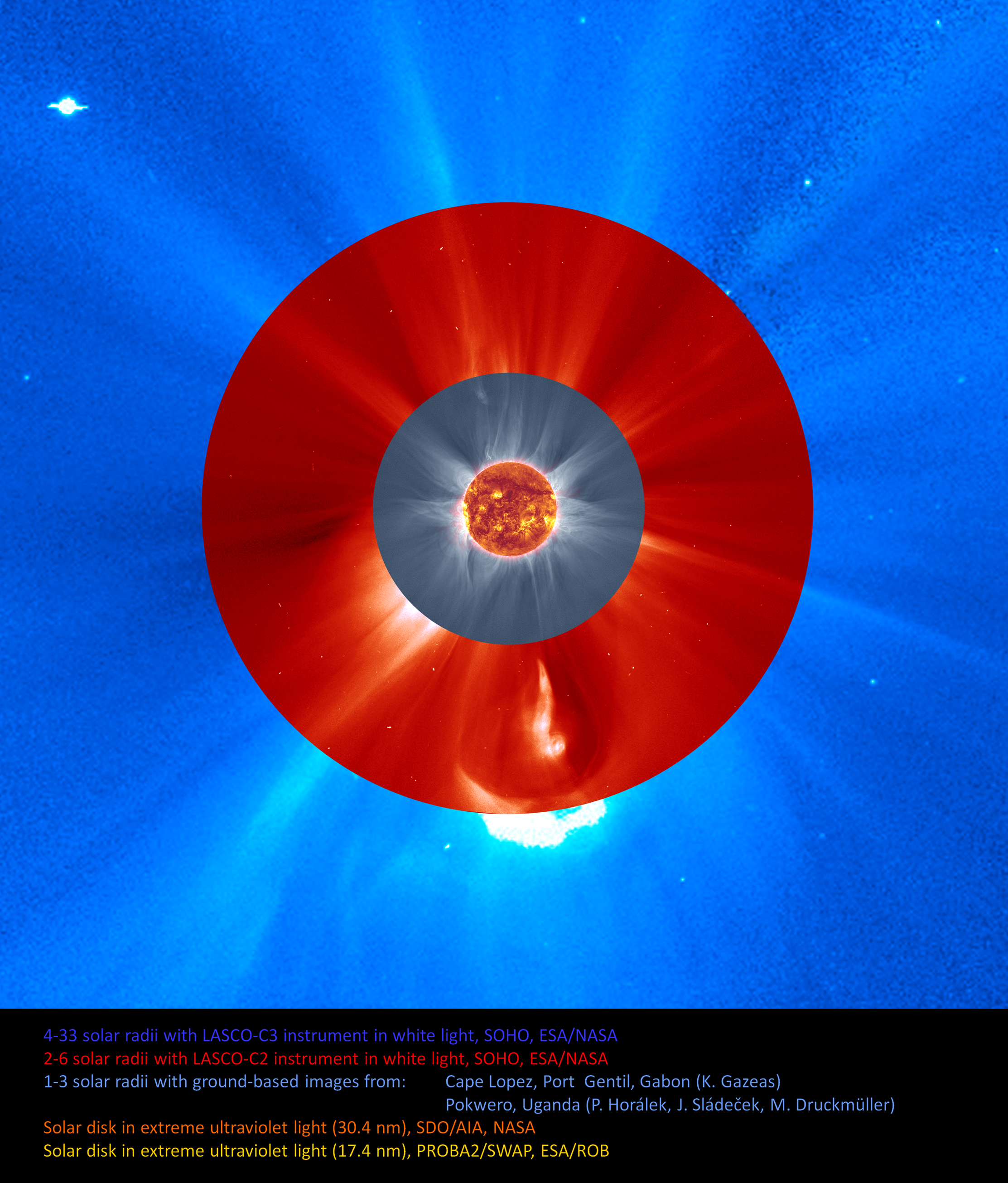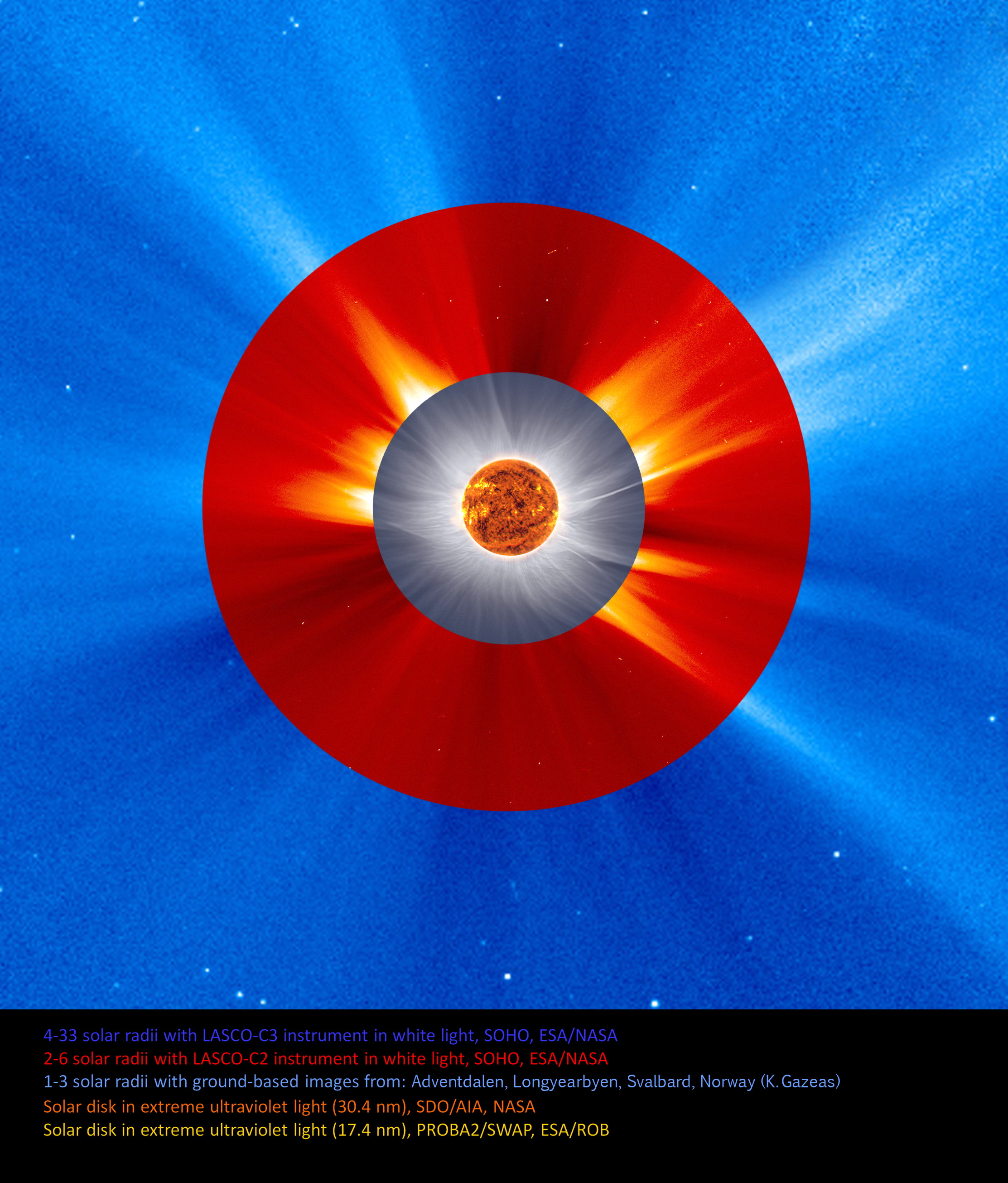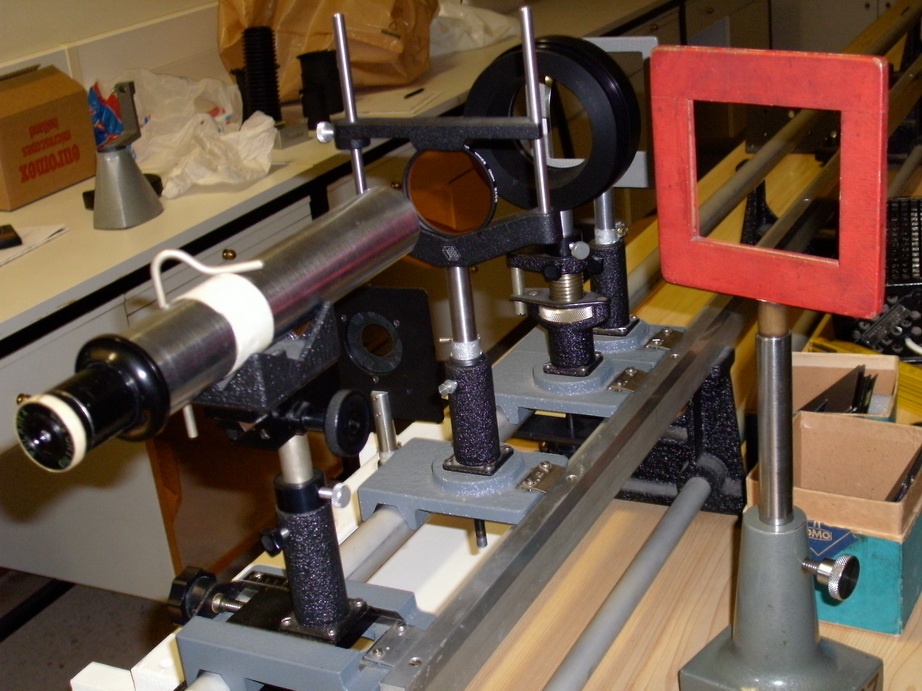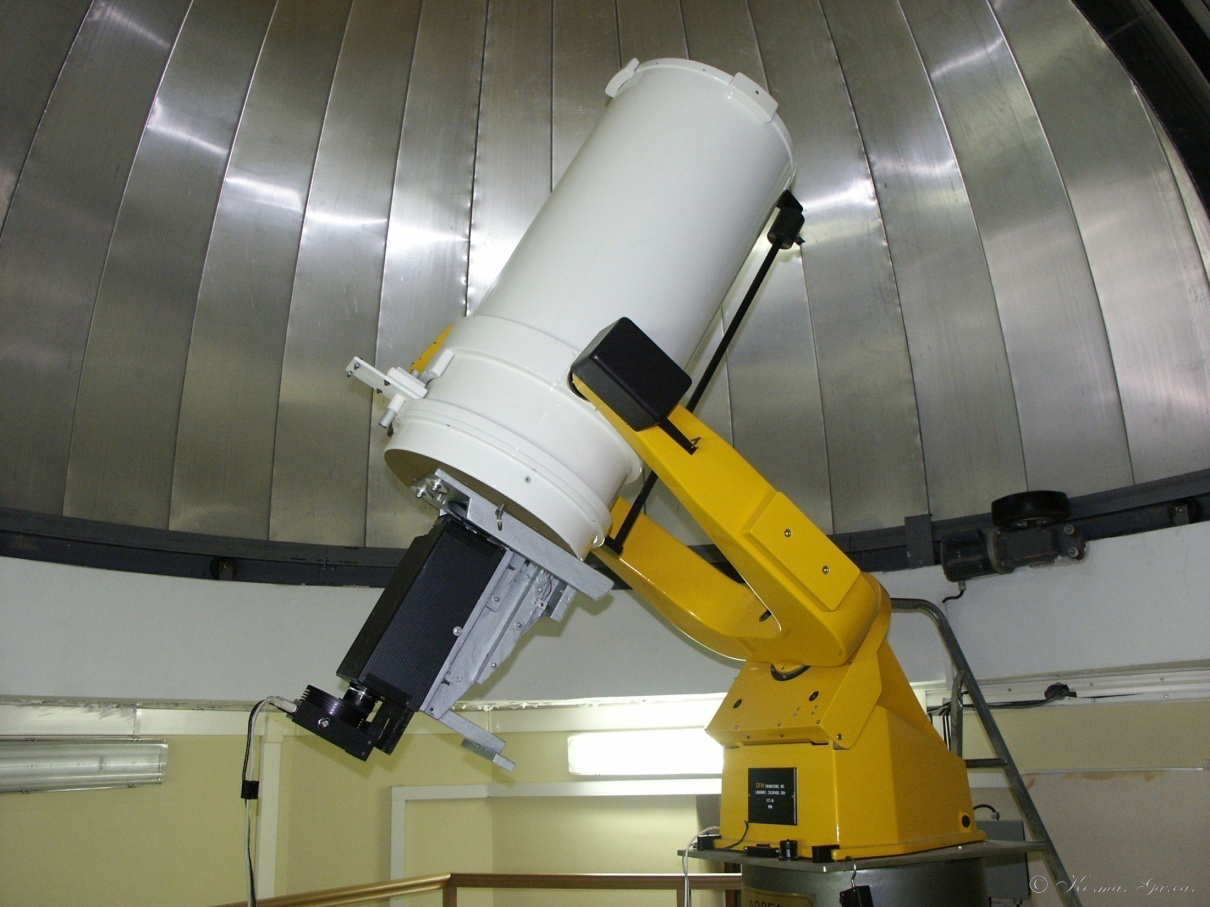7 things to know about the NASA rover about to land on Mars
With only about 50 million miles (80 million kilometers) left to go in its 293-million-mile (471-million-kilometer) journey, NASA's Mars 2020 Perseverance rover is nearing its new planetary home. The spacecraft has begun its approach to the Red Planet and in 43 days, on Feb. 18, 2021, Perseverance will blaze through Mars' atmosphere at about 12,100 mph (19,500 kph), touching down gently on the surface about seven minutes later.
Read more here: (details) If a planet has a lot of methane in its atmosphere, life is the most likely cause
The ultra-powerful James Webb Space Telescope will launch soon. Once it's deployed and in position at the Earth-Sun Lagrange Point 2, it'll begin work. One of its jobs is to examine the atmospheres of exoplanets and look for biosignatures. It should be simple, right? Just scan the atmosphere until you find oxygen, then close your laptop and head to the pub: Fanfare, confetti, Nobel prize.
Of course, Universe Today readers know it's more complicated than that. Much more complicated.
In fact, the presence of oxygen is not necessarily reliable. It's methane that can send a stronger signal indicating the presence of life.
Oxygen might seem like the obvious thing to look for in a planet's atmosphere when searching for signs of life, but that's not the case. Its presence or lack thereof is not a reliable indicator. Earth's history makes that clear.
Read more here: (details) Huge Puerto Rico radio telescope to close in blow to science
The National Science Foundation announced Thursday that it will close the huge telescope at the renowned Arecibo Observatory in Puerto Rico in a blow to scientists worldwide who depend on it to search for planets, asteroids and extraterrestrial life.
The independent, federally funded agency said it's too dangerous to keep operating the single dish radio telescope—one of the world's largest—given the significant damage it recently sustained. An auxiliary cable broke in August and tore a 100-foot hole in the reflector dish and damaged the dome above it. Then on Nov. 6, one of the telescope's main steel cables snapped, leading officials to warn that the entire structure could collapse.
Read more here: (details) First study with exoplanet satellite data describes one of the most extreme planets in the universe
CHEOPS keeps its promise: Observations with the space telescope have revealed details of the exoplanet WASP-189b—one of the most extreme planets known. CHEOPS is a joint mission by the European Space Agency (ESA) and Switzerland, under the aegis of the University of Bern in collaboration with the University of Geneva.
Eight months after the space telescope CHEOPS started its mission, the first scientific publication using data from CHEOPS has been issued. CHEOPS is the first ESA mission dedicated to characterizing known exoplanets, those orbiting stars outside the solar system. Exoplanets were first found in 1995 by two Swiss astronomers, Michel Mayor and Didier Queloz, who were last year awarded the Nobel Prize for this discovery. CHEOPS was developed as part of a partnership between ESA and Switzerland. Under the leadership of the University of Bern and ESA, a consortium of more than 100 scientists and engineers from 11 European states was involved in constructing the satellite over five years. The Science Operations Center of CHEOPS is located at the observatory of the University of Geneva.
Read more here: (details) Hubble views edge of stellar blast
While appearing as a delicate and light veil draped across the sky, this image from the NASA/ESA Hubble Space Telescope actually depicts a small section of the Cygnus
supernova blast wave, located around 2,400 light-years away. The name of the supernova remnant comes from its position in the northern constellation of Cygnus (the Swan),
where it covers an area 36 times larger than the full moon.
The original supernova explosion blasted apart a dying star about 20 times more massive than our sun between 10,000 and 20,000 years ago. Since then, the remnant has expanded
60 light-years from its center. The shockwave marks the outer edge of the supernova remnant and continues to expand at around 220 miles per second.
Read more here: (details) Betelgeuse's mysterious dimming is due to an outburst
Recent observations of Betelgeuse have revealed that the star's unexpected and significant dimming periods in late 2019 and early 2020 were most likely caused by the
ejection and cooling of dense hot gases, and that the star may be going through another dimming period more than a year early.
Between October and November 2019, Hubble Space Telescope observed dense, heated material moving outward through the star's extended atmosphere at 200,000 miles per hour.
The following month, several ground-based telescopes observed a decrease in brightness in Betelgeuse's southern hemisphere, as if something was blocking light in this
region of the star. By February 2020, the star had lost more than two-thirds of its brilliance, a dimming visible even to the naked eye, creating buzz that the star
might be going supernova. Continued ultraviolet light spectroscopic observations with Hubble provided a timeline for researchers to follow, like breadcrumbs leading
back through time to pinpoint the source of the mysterious dimming.
Read more here: (details) Betelgeuse's mysterious dimming is due to an outburst
One of the biggest challenges in Earth-based astronomy is overcoming the effect of atmospheric turbulence on telescope image quality. This turbulence makes stars twinkle,
and measurement of its impact is referred to as 'seeing'. The less turbulence (the lower the seeing number) the better.
"The thinner boundary layer at Dome A makes it less challenging to locate a telescope above it, thereby giving greater access to the free atmosphere," said UBC astronomer
Bin Ma, lead author on the paper.
Currently, the highest performing observatories are located in high-altitude locations along the equator (Chile and Hawai'i) and offer seeing in the range of 0.6 to 0.8 arcseconds.
In general, the Antarctic has the potential for better seeing, owing to weaker turbulence in the free atmosphere, with an estimated range of 0.23 to 0.36 arcseconds at a location called Dome C.
Read more here: (details) Super-Earths discovered orbiting nearby red dwarf
The nearest exoplanets to us provide the best opportunities for detailed study, including searching for evidence of life outside the solar system. In research led by the
University of Göttingen, the RedDots team of astronomers has detected a system of super-Earth planets orbiting the nearby star Gliese 887, the brightest red dwarf star
in the sky. Super-Earths are planets which have a mass higher than the Earth's but substantially below those of our local ice giants, Uranus and Neptune. The newly
discovered super-Earths lie close to the red dwarf's habitable zone, where water can exist in liquid form, and could be rocky worlds. The results were published in the
journal Science.
The RedDots team of astronomers monitored the red dwarf, using the HARPS spectrograph at the European Southern Observatory in Chile. They used a technique known as
"Doppler wobble," which enables them to measure the tiny back and forth wobbles of the star caused by the gravitational pull of the planets. The regular signals
correspond to orbits of just 9.3 and 21.8 days, indicating two super-Earths—Gliese 887b and Gliese 887c—both larger than the Earth yet moving rapidly, much faster
even than Mercury. Scientists estimate the temperature of Gliese 887c to be around 70° C.
Read more here: (details) One billion stars and counting—the sky according to Gaia's second data release
Launched in 2013, ESA's Gaia satellite has been scanning the sky to measure the positions, distances and motions of more than one billion stars in our galaxy,
the Milky Way. The goal of the mission is to create the most detailed galactic map ever made, in order to investigate the Milky Way's past and future history
like never before.
This animation shows the satellite as it scans great circles around the sky. Eventually, the sky is unfolded to reveal the view of the Milky Way and neighbouring
galaxies, based on measurements of nearly 1.7 billion stars from the second Gaia data release. The map shows the total brightness and colour of stars observed by
Gaia in each portion of the sky between July 2014 and May 2016.
Read more here: (details) Spitzer Telescope Reveals the Precise Timing of a Black Hole Dance
Το διαστημικό τηλεσκόπιο υπερύθρου, το οποίο έχει πρόσφατα αποσυρθεί από την ενεργό δράση του, συνεισέφερε σε μια εντυπωσιακή ανακάλυψη, πραγματοποιώντας τις τελευταίες παρατηρήσεις του,
σε συνδυασμό με τα επίγεια αστεροσκοπεία. Η παρατήρηση αφορά τη διπλή υπερμεγέθη μελανή οπή με όνομα OJ287 στον αστερισμό του Καρκίνου και την προβλεπόμενη έκλαμψή του, που συνέβη τον
Ιούλιο του 2019. Οι δύο μελανές οπές βρίσκονται σε τροχιά η μία γύρω από την άλλη, έχοντας περίοδο 12 ετών. Κάθε φορά που ο δίσκος προσαύξησης της μίας συγκρούεται με τον δίσκο της άλλης,
εμφανίζεται μια έκλαμψη, ορατή από τη Γη. Τη στιγμή που προβλεπόταν μια σημαντική έκλαμψη η πηγή OJ287 δεν ήταν ορατή από τη Γη, καθώς βρισκόταν πίσω από τον Ήλιο. Το διαστημικό τηλεσκόπιο
Spitzer όμως βρισκόταν σε κατάλληλη θέση για την παρατήρηση του φαινομένου και επιβεβαίωσε περίτρανα την πρόβλεψη. Οι παρατηρήσεις από το διάστημα συνδυάστηκαν με τις φωτομετρικές παρατηρήσεις
από τη Γη επί σειρά ετών, ώστε να αποκαλυφθεί η ισχυρά μεταβαλλόμενη τροχιά των δύο μελανών οπών. Η συνεισφορά του Γεροσταθοπούλειου Πανεπιστημιακού Αστεροσκοπείου Αθηνών (UOAO) ήταν σημαντική
στη μελέτη αυτή, καθώς το τηλεσκόπιο στην Αθήνα παρατηρεί ανελλιπώς τον ιδιάζοντα αυτόν στόχο από το 2006 στο πλαίσιο του προγράμματος μακροχρόνιας φωτομετρικής επισκόπισης των blazars με
τίτλο 'BOSS Project'. Η ανακάλυψη αυτή συνεισφέρει στην επιβεβαίωση του "no-hair theorem", το οποίο είναι υπό συζήτηση τα τελευταία χρόνια στην ευρύτερη επιστημονική κοινότητα.
Η πρωτότυπη δημοσίευση της εργασίας βρίσκεται εδώ: (δημοσίευση) Για περισσότερες πληροφορίες, επισκεφτείτε τα δελτία τύπου από το Spitzer, JPL, NASA:
(Spitzer)
(JPL)
(NASA)
(BBC News) NASA's James Webb Space Telescope full mirror deployment a success
In a recent test, NASA's James Webb Space Telescope fully deployed its primary mirror into the same configuration it will have when in space.
As Webb progresses towards liftoff in 2021, technicians and engineers have been diligently checking off a long list of final tests the observatory
will undergo before being packaged for delivery to French Guiana for launch. Performed in early March, this procedure involved commanding the
spacecraft's internal systems to fully extend and latch Webb's iconic 21 feet 4-inch (6.5 meter) primary mirror, appearing just like it would
after it has been launched to orbit. The observatory is currently in a cleanroom at Northrop Grumman Space Systems in Redondo Beach, California.
Διαβάστε περισσότερα εδώ: (πληροφορίες) How interferometry works, and why it's so powerful for astronomy
When astronomers talk about an optical telescope, they often mention the size of its mirror. That's because the larger your mirror, the sharper your view of
the heavens can be. It's known as resolving power, and it is due to a property of light known as diffraction. When light passes through an opening, such as
the opening of the telescope, it will tend to spread out or diffract. The smaller the opening, the more the light spreads, making your image more blurry.
This is why larger telescopes can capture a sharper image than smaller ones.
Διαβάστε περισσότερα εδώ: (πληροφορίες) TESS mission uncovers its first world with two stars
In 2019, when Wolf Cukier finished his junior year at Scarsdale High School in New York, he joined NASA's Goddard Space Flight Center in Greenbelt, Maryland, as a summer intern. His job was to examine variations in star brightness captured by NASA's Transiting Exoplanet Survey Satellite (TESS) and uploaded to the Planet Hunters TESS citizen science project.
Διαβάστε περισσότερα εδώ: (πληροφορίες) New evidence shows that the key assumption made in the discovery of dark energy is in error
The most direct and strongest evidence for the accelerating universe with dark energy is provided by the distance measurements using type Ia supernovae (SN Ia) for the galaxies at high redshift. This result is based on the assumption that the corrected luminosity of SN Ia through the empirical standardization would not evolve with redshift.
Διαβάστε περισσότερα εδώ: (πληροφορίες) Blazar variability
Active galactic nuclei (AGN) are supermassive black holes at the centers of galaxies that are accreting material. These AGN emit jets of charged particles that move at speeds close to that of light,
transporting huge amounts of energy away from the central black hole region and radiating across the electromagnetic spectrum. Blazars are extreme examples of AGN in which the collimated jets are
coincidentally aligned towards us. Blazar jets have two peak emission wavelengths, one that spans the range from the radio to the X-ray, the result of charged particle acceleration, and one at
extremely short wavelength, high energy gamma ray bands usually (and somewhat controversially) attributed to the charged particles scattering infrared "seed" photons from a variety of other sources.
All these bands manifest strong and unpredictable variability. Simultaneous, long-term observations across multiple bands therefore, by modeling the relative timing of flares and other variable emission,
offer a valuable way to investigate the numerous possible physical mechanisms at work.
Διαβάστε περισσότερα εδώ: (πληροφορίες) Δακτυλιοειδής Έκλειψη Ηλίου από το Ομάν
Διαβάστε περισσότερα εδώ: (πληροφορίες) Evidence suggests some super-puffs might be ringed exoplanets
A pair of researchers from the Observatories of the Carnegie Institution for Science and the California Institute of Technology have reported evidence that some super-puff exoplanets might be ringed exoplanets. Anthony Piro and Shreyas Vissapragada have written a paper describing their theory and the evidence supporting it and have posted it on the arXiv preprint server.
Διαβάστε περισσότερα εδώ: (πληροφορίες) Mercury skips across sun's vast glare in rare transit
Mercury skipped across the vast, glaring face of the sun Monday in a rare celestial transit.
Stargazers used solar-filtered binoculars and telescopes to spot Mercury—a tiny black dot—as it passed directly between Earth and the sun on Monday.
The eastern U.S. and Canada got the whole 5 ½-hour show, weather permitting, along with Central and South America. The rest of the world, except for Asia and Australia, got just a sampling.
Mercury is the solar system's smallest, innermost planet. The next transit isn't until 2032, and North America won't get another shot until 2049.
Τη Δευτέρα 11 Νοεμβρίου 2019 πραγματοποιήθηκε η παρατήρηση της διάβασης του πλανήτη Ερμή από το Γεροσταθοπούλειο Πανεπιστημιακό Αστεροσκοπείο Αθηνών, στο Τμήμα Φυσικής του ΕΚΠΑ. Αν και οι καιρικές συνθήκες δεν ήταν ευνοϊκές, οι περίπου 200 επισκέπτες παρατήρησαν το φαινόμενο με το τηλεσκόπιο του Αστεροσκοπείου, ενώ παρακολούθησαν τη διάβαση και μέσω online streaming από τα Αστεροσκοπεία Ålesund της Νορβηγίας και Greenwich της Αγγλίας. Παράλληλα με τις επίγειες παρατηρήσεις, ο δορυφόρος SDO της NASA κατέγραψε το φαινόμενο και μετέδωσε σχεδόν σε πραγματικό χρόνο τη διάβαση από το διάστημα. Οι τελευταίες φάσεις του φαινομένου δεν ήταν ορατές από την Αθήνα, καθώς ο ουρανός καλύφθηκε από σύννεφα.
Η παρατήρηση και καταγραφή του φαινομένου έγινε με επιτυχία, καθώς το πλήθος των επισκεπτών έφυγε με ενθουσιασμό και καλές εντυπώσεις από την ξενάγηση, την παρουσίαση του φαινομένου, αλλά και την παρατήρηση, ακόμη και μέσα από αραιή νέφωση. Η εκδήλωση έγινε με τη βοήθεια προπτυχιακών και μεταπτυχιακών φοιτητών του Τμήματος Φυσικής, υπό την εποπτεία και καθοδήγηση του Δρ. Κοσμά Γαζέα, Λέκτορα Αστροφυσικής.
Διαβάστε περισσότερα εδώ: (πληροφορίες) TESS reveals an improbable planet
Using asteroseismology, a team led by an Instituto de Astrofísica e Ciências do Espaço (IA) researcher studied two red-giant stars known to have exoplanets, and around one of them, found a seemingly improbable planet.
The team studied the red-giant stars HD 212771 and HD 203949. These are the first detections of oscillations in previously known exoplanet-host stars by TESS. The result was published today in an article in the Astrophysical Journal.
Διαβάστε περισσότερα εδώ: (πληροφορίες) Frequent flaring of Proxima Centauri means bad news for its rocky planet
Proxima Centauri is a cool red dwarf with about one-eighth of the sun's mass. Although it is the closest star to the sun, located just 4.2 light-years from the solar system in the triple star system of alpha Centauri, it is not visible to the naked eye. What makes this star particularly interesting is the recent discovery of an Earth-like exoplanet in its habitable zone: a region around the central star where the presence of liquid water is possible on a planetary surface.
Διαβάστε περισσότερα εδώ: (πληροφορίες) Σπάνια διάβαση του Διεθνούς Διαστημικού Σταθμού
Ο Διεθνής Διαστημικός Σταθμός (International Space Station - ISS) περιφέρεται γύρω από τη Γη κάθε 92.7 λεπτά. Συχνά τον βλέπουμε στον νυχτερινό ουρανό ως φωτεινό δορυφόρο, αλλά σπάνια τον βλέπουμε να διασχίζει με την τροχιά του τον δίσκο της Σελήνης ή του Ήλιου.
Η φωτογραφία απεικονίζει τη διάβαση του ISS μπροστά από τον Ήλιο στις 29 Αυγούστου 2019, σε μια σπάνια ευκαιρία που είχαν οι κάτοικοι του λεκανοπεδίου Αττικής να παρατηρήσουν την προβολή του σταθμού μπροστά απο τον ηλιακό δίσκο.
Η παρατήρηση πραγματοποιήθηκε από τον Δρ. Κοσμά Γαζέα, με φορητό αστρονομικό εξοπλισμό από το Κτήμα Συγγρού στην Κηφισιά. Οι λήψεις γίνονταν με ρυθμό 30 καρέ το δευτερόλεπτο, ενώ η διάβαση διήρκησε μόλις 0.7 sec.
Το video της διάβασης μπορείτε να το δείτε εδώ. Διαβάστε περισσότερα εδώ: (πληροφορίες) Discovering the shortest orbital period eclipsing binary known
Observations made with a new instrument developed for use at the 2.1-meter (84-inch) telescope at the National Science Foundation's Kitt Peak National Observatory
have led to the discovery of the fastest eclipsing white dwarf binary yet known. The system consists of two white dwarfs orbiting each other in an orbit so close
that the whole binary could fit completely inside of the planet Saturn. Clocking in with an orbital period of only 6.91 minutes, the rapidly orbiting
stars are expected to be one of the strongest sources of gravitational waves detectable with LISA, the future space-based gravitational wave detector.
Για να διαβάσετε το αυθεντικό άρθρο που δημοσιεύθηκε, πατήστε εδώ Διαβάστε περισσότερα εδώ: (πληροφορίες) Η ολική έκλειψη Ηλίου της χρονιάς
Λίγες ώρες έμειναν μέχρι το μεγάλο αστρονομικό γεγονός της χρονιάς.
Διαβάστε περισσότερα εδώ: (πληροφορίες) NASA's TESS mission finds its smallest planet yet
NASA's Transiting Exoplanet Survey Satellite (TESS) has discovered a world between the sizes of Mars and Earth orbiting a bright,
cool, nearby star. The planet, called L 98-59b, marks the tiniest discovered by TESS to date.
Two other worlds orbit the same star. While all three planets' sizes are known, further study with other telescopes will be needed
to determine if they have atmospheres and, if so, which gases are present. The L 98-59 worlds nearly double the number of small
exoplanets—that is, planets beyond our solar system—that have the best potential for this kind of follow-up.
Διαβάστε περισσότερα εδώ: (πληροφορίες) A family of comets reopens the debate about the origin of Earth's water
Where did the Earth's water come from? Although comets, with their icy nuclei, seem like ideal candidates, analyses have so far shown
that their water differs from that in our oceans. Now, however, an international team, bringing together CNRS researchers at the
Laboratory for Studies of Radiation and Matter in Astrophysics and Atmospheres (Paris Observatory - PSL/CNRS/ Sorbonne University/University of Cergy-Pontoise)
and the Laboratory of Space Studies and Instrumentation in Astrophysics (Paris Observatory - PSL/CNRS/Sorbonne University/University of Paris),
has found that one family of comets, the hyperactive comets, contains water similar to terrestrial water. The study, published in the journal
Astronomy & Astrophysics on May 20, 2019, is based in particular on measurements of comet 46P/Wirtanen carried out by SOFIA, NASA's Stratospheric
Observatory for Infrared Astronomy.
Διαβάστε περισσότερα εδώ: (πληροφορίες) Curiosity captured two solar eclipses on Mars
When NASA's Curiosity Mars rover landed in 2012, it brought along eclipse glasses. The solar filters on its Mast Camera (Mastcam)
allow it to stare directly at the Sun. Over the past few weeks, Curiosity has been putting them to good use by sending back some
spectacular imagery of solar eclipses caused by Phobos and Deimos, Mars' two moons.
Phobos, which is about 7 miles (11.5 kilometers) across, was imaged on March 26, 2019 (the 2,359th sol, or Martian day, of
Curiosity's mission); Deimos, which is about 1.5 miles (2.3 kilometers) across, was photographed on March 17, 2019 (Sol 2350).
Phobos doesn't completely cover the Sun, so it would be considered an annular eclipse. Because Deimos is so small compared to
the disk of the Sun, scientists would say it's transiting the Sun.
Διαβάστε περισσότερα εδώ: (πληροφορίες) Data flows from NASA's TESS Mission, leads to discovery of Saturn-sized planet
Astronomers who study stars are providing a valuable assist to the planet-hunting astronomers pursuing the primary objective of NASA's new TESS Mission.
In fact, asteroseismologists—stellar astronomers who study seismic waves (or "starquakes") in stars that appear as changes in brightness—often provide
critical information for finding the properties of newly discovered planets.
This teamwork enabled the discovery and characterization of the first planet identified by TESS for which the oscillations of its host star can be measured.
Διαβάστε περισσότερα εδώ: (πληροφορίες) Tiny Object Found at the Edge of the Solar System
The Kuiper Belt, or the Edgeworth-Kuiper Belt, is home to ancient rocks. Kuiper Belt Objects, or KBOs, are remnants of the early
planet-formation days of our Solar System. Small KBOs, in the 1 km. diameter range, have been theorized about for decades, but
nobody’s every found one.
Διαβάστε περισσότερα εδώ: (πληροφορίες) NASA rings in New Year with historic flyby of faraway world
NASA rang in the New Year on Tuesday with a historic flyby of the farthest, and quite possibly the oldest, cosmic body ever explored by humankind—a tiny,
distant world called Ultima Thule—in the hopes of learning more about how planets took shape.
It was 07:33 am (05:33 GMT) when the New Horizons spacecraft aimed its cameras at the space rock
four billion miles (6.4 billion kilometers) away in a dark and frigid region of space known as the Kuiper Belt.
Offering scientists the first up-close look at an ancient building block of planets, the flyby took place about a billion miles beyond Pluto, which was
until now the most faraway world ever visited up close by a spacecraft.
Real-time video of the actual flyby was impossible, since it takes more than six hours for a signal sent from Earth to reach the spaceship, and another
six hours for the response to arrive.
Διαβάστε περισσότερα εδώ: (πληροφορίες) Astronomers discover nine new variable stars
A team of astronomers from Chile has detected nine new variable stars in the globular cluster NGC 6652 and its background stream.
Six of the newly found stars were classified as eclipsing binaries, one as an SX Phoenicis star, and two remain unclassified.
Variable stars could offer important hints into aspects of stellar structure and evolution. They could be also helpful for better
understanding of the distance scale of the universe.
In particular, studies of variable stars in star clusters are of special interest for astronomers as they have the potential to help
identify systematic errors that affect stellar distance indicators. However, although stellar variability in globular clusters (GCs)
of the Milky Way galaxy is one of the oldest branches of astronomy, there are still many galactic GCs in which the census of their
variable star content is far from complete.
Διαβάστε περισσότερα εδώ: (πληροφορίες) Mars touchdown: NASA spacecraft survives supersonic plunge
A NASA spacecraft designed to drill down into Mars' interior landed on the planet Monday after a perilous, supersonic plunge through its red skies,
setting off jubilation among scientists who had waited in white-knuckle suspense for confirmation to arrive across 100 million miles of space.
Flight controllers at NASA's Jet Propulsion Laboratory in Pasadena, California, leaped out of their chairs, screaming, dancing and hugging, upon
learning that InSight had arrived on Mars, the graveyard for a multitude of previous missions.
"Touchdown confirmed!" a flight controller called out just before 3 p.m. EST, instantly dispelling the anxiety that had gripped the control room
as the spacecraft made its six-minute descent.
Διαβάστε περισσότερα εδώ: (πληροφορίες) Ultra-close stars discovered inside a planetary nebula
An international team of astronomers have discovered two stars in a binary pair that complete an orbit around each other in a little over three hours,
residing in the planetary nebula M3-1. Remarkably, the stars could drive a nova explosion, an entirely unexpected event based on our current
understanding of binary star evolution.
Διαβάστε περισσότερα εδώ: (πληροφορίες) How Does a Black Hole Form?
There's something inherently fascinating about black holes. Maybe it's that they're invisible beasts lurking in space that sometimes rip passing stars
in half and scatter their remains. Whatever it is, these strange cosmic objects continue to captivate scientists and laypeople alike.
But where do black holes come from? How do they form, and what gives them such awesome destructive power?
Διαβάστε περισσότερα εδώ: (πληροφορίες) NASA's Opportunity Rover on Mars Still Silent 2 Months into Epic Dust Storm
It's now been more than two months since NASA's long-lived Opportunity Mars rover last phoned home.
Opportunity hasn't made a peep since June 10, when dust in the Red Planet's air got so thick that the solar-powered rover couldn't recharge its batteries.
Opportunity's handlers think the six-wheeled robot has put itself into a sort of hibernation, and they still hope to get a ping once the dust storm has petered out.
Διαβάστε περισσότερα εδώ: (πληροφορίες) First confirmed image of newborn planet
Astronomers led by a group at the Max Planck Institute for Astronomy in Heidelberg, Germany have captured a spectacular snapshot of planetary formation
around the young dwarf star PDS 70. By using the SPHERE instrument on ESO's Very Large Telescope (VLT)—one of the most powerful planet-hunting instruments
in existence—the international team has made the first robust detection of a young planet, named PDS 70b, cleaving a path through the planet-forming
material surrounding the young star.
Διαβάστε περισσότερα εδώ: (πληροφορίες) How solar prominences vibrate
An international team led by researchers from the Instituto de Astrofísica de Canarias (IAC) and the Universidad de La Laguna (ULL) has cataloged around 200 oscillations
of the solar prominences during the first half of 2014. Its development has been possible thanks to the GONG network of telescopes, of which one of them is located in the Teide Observatory.
When we look at the surface of the Sun the solar prominences are seen as dark filaments that populate the disk or as a blaze of plasma above it. Solar prominences are very dense plasma
structures that levitate in the solar atmosphere. It is generally believed that the star's magnetic field supports them so that they do not fall on the surface due to their own weight.
These magnetic structures can accumulate a large amount of energy that, when released, produces eruptions ejecting the prominence material into the interplanetary space.
Διαβάστε περισσότερα εδώ: (πληροφορίες) Ushering in the next phase of exoplanet discovery
Ever since scientists discovered the first planet outside of our solar system, 51 Pegasi b, the astronomical field of exoplanets has exploded,
thanks in large part to the Kepler Space Telescope. Now, with the successful launch of the Transiting Exoplanet Survey Satellite (TESS),
scientists see a revolution not only in the amount of new planetary data to analyze, but also in the potential for new avenues of scientific discovery.
So far, scientists have confirmed 3,717 exoplanets in 2,773 systems. As an all-sky survey, TESS will build on this, observing 85 percent of the cosmos
containing more than 200,000 nearby stars, and researchers expect to identify some 20,000 exoplanets.
Διαβάστε περισσότερα εδώ: (πληροφορίες) ExoMars returns first images from new orbit
The ExoMars Trace Gas Orbiter has returned the first images of the Red Planet from its new orbit. The spacecraft arrived in a near-circular 400 km altitude orbit
a few weeks ago ahead of its primary goal to seek out gases that may be linked to active geological or biological activity on Mars.
The orbiter's Colour and Stereo Surface Imaging System, CaSSIS, took this stunning image, which features part of an impact crater, during the instrument's test period.
The camera was activated on 20 March and was tested for the start of its main mission on 28 April.
Διαβάστε περισσότερα εδώ: (πληροφορίες) 70-year-old mystery of how magnetic waves heat the Sun cracked
Scientists at Queen's University Belfast have led an international team to the ground-breaking discovery that magnetic waves crashing through the Sun may be key to heating
its atmosphere and propelling the solar wind.
The Sun is the source of energy that sustains all life on Earth but much remains unknown about it. However, a group of researchers at Queen's have now unlocked some mysteries
in a research paper, which has been published in Nature Physics.
In 1942, Swedish physicist and engineer Hannes Alfvén predicted the existence of a new type of wave due to magnetism acting on a plasma, which led him to obtain the Nobel Prize
for Physics in 1970. Since his prediction, Alfvén waves have been associated with a variety of sources, including nuclear reactors, the gas cloud that envelops comets, laboratory
experiments, medical MRI imaging and in the atmosphere of our nearest star -- the Sun.
Scientists have suggested for many years that these waves may play an important role in maintaining the Sun's extremely high temperatures but until now had not been able to prove it.
Διαβάστε περισσότερα εδώ: (πληροφορίες) Eclipse season starts for NASA's SDO
On Sunday, Feb. 11, 2018, NASA's Solar Dynamics Observatory, or SDO, saw a total solar eclipse in space when Earth crossed its view of the Sun. Also known as a transit,
Earth's passage was brief, lasting from 2:10 a.m. to 2:41 a.m. EST and covering the entire face of the Sun. So marks the beginning of SDO's eclipse season—as well as the
mission's eighth launch anniversary. SDO's eclipse season is a three-week period that comes twice a year near the equinoxes during which Earth blocks SDO's view of the
Sun for a short while each day. The eclipses are fairly short near the beginning and end of the season but ramp up to 72 minutes in the middle. Most spacecraft observing
the Sun from an orbit around Earth have to contend with such eclipses. SDO's orbit is designed to maximize the amount of data the spacecraft can send back to Earth, but
twice a year Earth gets in the way of the spacecraft's view. The spring eclipse season began on Feb. 10 with a partial eclipse and concludes March 5, 2018.
Διαβάστε περισσότερα εδώ: (πληροφορίες) A better way to weigh millions of solitary stars
Astronomers have come up with a new and improved method for measuring the masses of millions of solitary stars, especially those with planetary systems.
Getting accurate measurements of how much stars weigh not only plays a crucial role in understanding how stars are born, evolve and die, but it is also essential in
assessing the true nature of the thousands of exoplanets now known to orbit most other stars.
The method is tailor-made for the European Space Agency's Gaia Mission, which is in the process of mapping the Milky Way galaxy in three dimensions, and NASA's upcoming
Transiting Exoplanet Survey Satellite (TESS), which is scheduled for launch next year and will survey the 200,000 brightest stars in the firmament looking for alien earths.
"We have developed a novel method for 'weighing' solitary stars," said Stevenson Professor of Physics and Astronomy Keivan Stassun, who directed the development.
"First, we use the total light from the star and its parallax to infer its diameter. Next, we analyze the way in which the light from the star flickers, which provides
us with a measure of its surface gravity. Then we combine the two to get the star's total mass."
Διαβάστε περισσότερα εδώ: (πληροφορίες) Discovery of new planet reveals distant solar system to rival our own
The discovery of an eighth planet circling the distant star Kepler-90 by University of Texas at Austin astronomer Andrew Vanderburg and Google's Christopher Shallue
overturns our solar system's status as having the highest number of known planets. We're now in a tie.
The newly discovered Kepler-90i—a sizzling hot, rocky planet orbiting its star once every 14.4 days—was found using computers that "learned" to find planets in data
from NASA's Kepler space telescope. Kepler finds distant planets beyond the solar system, or exoplanets, by detecting the minuscule change in brightness when a planet
transits (crosses in front of) a star.
Vanderburg, a NASA Sagan fellow at UT Austin, and Shallue, a Google machine learning researcher, teamed up to train a computer to learn how to identify signs of an
exoplanet in the light readings from distant stars recorded by Kepler. Similar to the way neurons connect in the human brain, this "neural network" sifted through the
Kepler data to identify the weak transit signals from a previously missed eighth planet orbiting Kepler-90, a sun-like star 2,545 light-years from Earth in the constellation Draco.
"For the first time since our solar system planets were discovered thousands of years ago, we know for sure that our solar system is not the sole record holder for the
most planets," Vanderburg said.
Διαβάστε περισσότερα εδώ: (πληροφορίες) Fifty years ago, Jocelyn Bell discovered pulsars!
A pulsar is a small, spinning star – a giant ball of neutrons, left behind after a normal star has died in a fiery explosion.
With a diameter of only 30 km, the star spins up to hundreds of times a second, while sending out a beam of radio waves (and sometimes other radiation, such as X-rays).
When the beam is pointed in our direction and into our telescopes, we see a pulse.
2017 marks 50 years since pulsars were discovered. In that time, we have found more than 2600 pulsars (mostly in the Milky Way), and used them to hunt for low-frequency
gravitational waves, to determine the structure of our galaxy and to test the general theory of relativity.
The discovery
In mid-1967, when thousands of people were enjoying the summer of love, a young PhD student at the University of Cambridge in the UK was helping to build a telescope.
It was a poles-and-wires affair – what astronomers call a "dipole array". It covered a bit less than two hectares, the area of 57 tennis courts.
By July it was built. The student, Jocelyn Bell (now Dame Jocelyn Bell Burnell), became responsible for running it and analysing the data it churned out. The data came
in the form of pen-on-paper chart records, more than 30 metres of them each day. Bell analysed them by eye.
Διαβάστε περισσότερα εδώ: (πληροφορίες) Ο νάνος πλανήτης Haumea έχει δακτύλιο!
Κατά τη διάρκεια μια σπάνιας επιπρόσθησης ενός μακρινού αστέρα από έναν μικροσκοπικό πλανήτη, έγινε μια απρόσμενη ανακάλυψη: Ο νάνος πλανήτης Haumea βρέθηκε να έχει έναν δακτύλιο από σκόνη και θραύσματα πάχους 43 μιλίων (70 km).
Η Haumea είναι πλέον επίσημα ο πρώτος νάνος πλανήτης που έχει ένα σύστημα δακτυλίων, ενώ μέχρι σήμερα γνωρίζαμε ότι αυτό ήταν προνόμιο μόνο των τεσσάρων αέριων γιγάντων πλανητών του Ηλιακού Συστήματος (Δίας, Κρόνος, Ουρανός, Ποσειδώνας) και
του μικρού αστεροειδή με όνομα Χαρικλώ.
Η ανακάλυψη αυτή σηματοδοτεί και την πρώτη φορά που έχουν βρεθεί δακτύλιοι σε ένα αντικείμενο της ζώνης Kuiper, η οποία είναι μια περιοχή με παγωμένα αντικείμενα πέρα από την τροχιά του Ποσειδώνα.
Η πρωτότυπη δημοσίευση βρίσκεται εδώ.
Διαβάστε περισσότερα εδώ: wiki και εδώ: (πληροφορίες) Fly me to the Moon
By 2040, a hundred people will live on the Moon, melting ice for water, 3D-printing homes and tools, eating plants grown in lunar soil, and competing in low-gravity, "flying" sports.
To those who mock such talk as science fiction, experts such as Bernard Foing, ambassador of the European Space Agency-driven "Moon Village" scheme, reply the goal is not only reasonable but feasible too.
At a European Planetary Science Congress in Riga this week, Foing spelt out how humanity could gain a permanent foothold on Earth's satellite, and then expand.
The 1969-72 Apollo landings left us with an image of a lunar environment that was hostile and sterile. But scientists today says there is bounty in the Moon that can be unlocked
with advanced technology, opening the way to a permanent human colony.
Read more here: (details) Μερική Έκλειψη Σελήνης - 7 Αυγούστου 2017
Στις 7 Αυγούστου 2017 θα γίνει ορατή από την Ελλάδα μια Μερική Έκλειψη Σελήνης. Το ποσοστό της απόκρυψης στην έκλειψη αυτή αγγίζει το 25% και έτσι η γήινη σκιά
θα καλύψει μόλις το 1/4 της σεληνιακής επιφάνειας. Το φαινόμενο θα είναι ορατό κατά τις πρώτες βραδινές ώρες και ιδιαίτερα κατά την ανατολή της Πανσελήνου από
τον ανατολικό ορίζοντα. Η ανατολή της Σελήνης αναμένεται να πραγματοποιηθεί κατά τις 20:20 (τοπική ώρα), ταυτόχρονα με την έναρξη του φαινομένου.
Η κορύφωση της έκλειψης θα σημειωθεί στις 21:22, όταν η Σελήνη θα βρίσκεται λίγες μοίρες επάνω από τον ορίζοντα, ενώ το φαινόμενο θα λήξει στις 22:20,
όταν η Σελήνη θα εξέλθει από τη σκιά της Γης. Η μερική αυτή έκλειψη θα είναι ορατή από όλες τις περιοχές της Ελλάδας, ενώ μετά τη λήξη του φαινομένου η
Πανσέληνος θα λάμπει κανονικά στον ουρανό για την υπόλοιπη νύχτα. Μην ξεχάσετε λοιπόν να απολαύσετε την Αυγουστιάτικη Πανσέληνο όπου κι αν βρίσκεστε,
σε συνδυασμό με το φαινόμενο της μερικής έκλειψης!
Η Μερική Έκλειψη Σελήνης, όπως φωτογραφήθηκε από το Πανεπιστημιακό Αστεροσκοπείο Αθηνών στις 25 Απριλίου 2013 από τον Δρ. Κ. Γαζέα.
Read more here: (details) Ολική Έκλειψη Ηλίου - 21 Αυγούστου 2017
Στις 21 Αυγούστου 2017 οι κάτοικοι της βορείου Αμερικής θα παρατηρήσουν τον Ήλιο να αποκρύπτεται σταδιακά από τη Σελήνη, μετατρέποντας την ημέρα σε νύχτα.
Ταυτόχρονα, η θερμοκρασία θα πέσει αισθητά, ενώ στον ουρανό θα φανούν αστέρια και πλανήτες, ενώ ο Ήλιος θα εμφανίσει τους πίδακες πλάσματος που περιβάλλουν το ηλιακό στέμμα.
Την ημέρα αυτή, οι ΗΠΑ θα βρίσκονται στο μονοπάτι της σκιάς της Σελήνης, σε μια Ολική Έκλειψη Ηλίου.
Η συγκεκριμένη έκλειψη αποκαλείται "Great American Total Solar Eclipse" και η σκιά της Σελήνης διασχίζει τους ουρανούς από το Oregon μέχρι τη South Carolina, σε μια ζώνη μόλις 113 χιλιομέτρων στο έδαφος.
Όσοι βρεθούν μέσα σε αυτήν τη "ζώνη της ολικότητας" θα γίνουν μάρτυρες ενός εξαιρετικά εντυπωσιακού φαινομένου.
Η Ολική Έκλειψη Ηλίου, όπως φωτογραφήθηκε από το Svalbard της Νορβηγίας στις 20 Μαρτίου 2015 από τον Δρ. Κ. Γαζέα.
Read more here: (details) Four new short-period giant planets discovered Read more here: (details) Japan reveals plans to put a man on moon by 2030
Japan has revealed ambitious plans to put an astronaut on the Moon around 2030 in new proposals from the country's space agency.
This is the first time the Japan Aerospace Exploration Agency (JAXA) has said it aims to send an astronaut beyond the International Space Station, an agency spokeswoman told AFP on Friday.
The idea is to first join a NASA-led mission in 2025 to build a space station in the moon's orbit, as part of a longer-term effort by NASA to reach Mars.
Tokyo hopes that contributing to the multinational mission and sharing Japanese technology will land it a coveted spot at the station, from which it could eventually send an astronaut to the Moon, the spokeswoman said.
Japan has unveiled ambitious plans to put an astronaut on the moon around 2030 under new proposals from the country's space agency.
Read more here: (details) Construction begins on the world's first super telescope
Scientists are a step closer to understanding the inner-workings of the universe following the laying of the first stone, and construction starting on the world's largest optical and infrared telescope.
With a main mirror 39 metres in diameter, the Extremely Large Telescope (ELT), is going to be, as its name suggests, enormous. Unlike any other before it, ELT is also designed to be an adaptive telescope and has the ability to correct atmospheric turbulence, taking telescope engineering to another level.
To mark the construction's milestone, a ceremony was held at ESO's Paranal residencia in northern Chile, close to the site of the future giant telescope which will be on top of Cerro Armazones, a 3046-metre peak mountain.
Artist's impression of the European Extremely Large Telescope (E-ELT) in its enclosure on Cerro Armazones. A 3046-metre mountaintop in Chile's Atacama Desert. The 39-metre E-ELT will be the largest optical/infrared telescope in the world.
Read more here: (details) Brown dwarf binary discovered by microlensing
Using gravitational microlensing, astronomers have recently found a binary star composed of two brown dwarfs. The newly discovered system is the third brown-dwarf binary detected with this technique. The finding was presented in a paper published May 16 on the arXiv pre-print server.
Gravitational microlensing is an invaluable method of detecting new extrasolar planets and brown dwarfs, regardless of the light they emit. This technique is therefore sensitive to the mass of the objects, rather than their luminosity, which allows astronomers to study objects that emit little or no light at all. Hence, due to their extremely low luminosities, brown-dwarf systems seem to be ideal targets for microlensing observations.
Light curve of the microlensing event OGLE-2016-BLG-1469. The upper panel shows the enlarged view of the anomaly around the peak.
Read more here: (details) Επιτυχία του ΕΚΠΑ στον διαγωνισμό του Europlanet Διαβάστε περισσότερα εδώ: Planets In Your Hand Πληροφορίες για το διαγωνισμό: Europlanet Η διάβαση του Ερμή στις 9 Μαΐου 2016
Οι πλανητικές διαβάσεις μπροστά από τον ηλιακό δίσκο είναι ένα σπάνιο φαινόμενο. Στο Ηλιακό μας Σύστημα μόνο ο Ερμής και η Αφροδίτη μπορούν
να προβληθούν επάνω στην Ήλιο, εφόσον η τροχιά τους είναι πιο μικρής ακτίνας από αυτήν της Γης. Ο Ερμής περιφέρεται γύρω από τον Ήλιο σε
ελλειπτική τροχιά κάθε 88 ημέρες. Ο συνδυασμός της τροχιακής περιόδου, της κλίσης της τροχιάς του και της απόστασής του από τον Ήλιο και τη Γη,
δημιουργεί τις κατάλληλες προϋποθέσεις για διάβαση περίπου 13-14 φορές μέσα σε έναν αιώνα. Οι πιο πρόσφατες διαβάσεις του πλανήτη Ερμή ήταν το 2003
(ορατή από την Ελλάδα) και το 2006 (αόρατη από την Ελλάδα) και η επόμενη είναι στις 9 Μαΐου 2016. Δεδομένου ότι οι μελλοντικές διαβάσεις του Ερμή
θα είναι το 2019 (μερικώς ορατή από Ελλάδα) και η επόμενη το 2032, γίνεται σαφές ότι το φαινόμενο της διάβασης είναι σχετικά σπάνιο.
Το Γεροσταθοπούλειο Πανεπιστημιακό Αστεροσκοπείο Αθηνών, του Τμ. Φυσικής ΕΚΠΑ διοργανώνει μια ημερίδα με αφορμή το σπάνιο αυτό αστρονομικό γεγονός.
Το φαινόμενο θα συμβεί κατά τις ώρες 11:12-18:42 UT (14:12-21:42 τοπική ώρα).
Η εκδήλωση θα λάβει χώρα στις 9 Μαΐου 2016 στο Τμήμα Φυσικής του ΕΚΠΑ από τις 16:00 μέχρι τις 22:00.
Διαβάστε περισσότερα εδώ: (Δελτίο Τύπου) (Αφίσα) Evidence for a habitable region within Saturn's moon Enceladus
Scientists from Southwest Research Institute (SwRI) have discovered hydrogen gas in the plume of material erupting from Saturn's moon Enceladus. Analysis of data from NASA's Cassini
spacecraft indicates that the hydrogen is best explained by chemical reactions between the moon's rocky core and warm water from its subsurface ocean. The SwRI-led team's discovery
suggests that Enceladus' ocean floor could include features analogous to hydrothermal vents on Earth, which are known to support life on the seafloor.
Read more here... (details) NASA tests robotic ice tools
Since 2015, NASA's Jet Propulsion Laboratory in Pasadena, California, has been developing new technologies for use on future missions to ocean worlds.
That includes a subsurface probe that could burrow through miles of ice, taking samples along the way; robotic arms that unfold to reach faraway objects;
and a projectile launcher for even more distant samples.
Read more here... (details) Comet 45P/Honda-Mrkos-Pajdušáková is coming!
Comet hunters still have a chance to see comet 45P/Honda-Mrkos-Pajdušáková in the next few days using binoculars or a telescope.
It's the first of a trio of comets that will-between now and the end of 2018-pass close enough to Earth for backyard observers to try to spot and for scientists to study using ground-based instruments.
Comet 45P will come closest to Earth on the morning of Saturday, Feb. 11, when it passes by at a distance of about 7.7 million miles (12.4 million kilometers),
or more than roughly 30 times the distance between Earth and the moon. It is currently in the early morning eastern sky, though the full moon may make the comet more difficult to spot.
Ground-based observations also are planned for comet 41P/Tuttle-Giacobini-Kresak, which will pass closest to Earth on April 1, 2017, and for comet 46P/Wirtanen, passing closest to Earth on Dec. 16, 2018.
Read more here... (details) A contact binary will explode in 2022!
Calvin College professor Larry Molnar and his students along with colleagues from Apache Point Observatory (Karen Kinemuchi) and the University of Wyoming (Henry Kobulnicky) are predicting
a change to the night sky that will be visible to the naked eye. Molnar's prediction is that a binary star he is monitoring will merge and explode in 2022, give or take a year; at which time
the star will increase its brightness ten thousand fold, becoming one of the brighter stars in the heavens for a time. The star will be visible as part of the constellation Cygnus, and will
add a star to the recognizable Northern Cross star pattern.
Read more here... (details) NASA seeks planets like those in 'Star Wars: Rogue One'
In the "Star Wars" universe, ice, ocean and desert planets burst from the darkness as your ship drops out of light speed. But these worlds might be more than just science fiction.
Some of the planets discovered around stars in our own galaxy could be very similar to arid Tatooine, watery Scarif and even frozen Hoth, according to NASA scientists. Sifting through data on the more than
3,400 confirmed alien worlds, scientists apply sophisticated computer modeling techniques to tease out the colors, light, sunrise and sunsets we might encounter if we could pay them a visit.
Some of these distant worlds are even stranger than those that populate the latest Star Wars film, "Rogue One: A Star Wars Story." And others are eerily like the fictional planets from a galaxy far, far away.
Read more here... (details) NASA completes Webb Telescope Center of Curvature pre-test
Engineers and technicians working on the James Webb Space Telescope successfully completed the first important optical measurement of Webb's fully assembled primary mirror, called a Center of Curvature test.
Taking a "before" optical measurement of the telescope's deployed mirror is crucial before the telescope goes into several stages of rigorous mechanical testing. These tests will simulate the violent sound
and vibration environments the telescope will experience inside its rocket on its way out into space. This environment is one of the most stressful structurally and could alter the shape and alignment of
Webb's primary mirror, which could degrade or, in the worst case, ruin its performance.
Read more here... (details) New crater on the Moon!
The moon's surface is being "gardened" by small impacts—more than 100 times faster than scientists previously thought. This means that surface features believed to be young are perhaps
even younger than assumed. It also means that any structures placed on the moon as part of human expeditions will need better protection.
This new discovery comes from more than seven years of high-resolution lunar images studied by a team of scientists from Arizona State University and Cornell University.
The team is led by ASU's Emerson Speyerer, who is also the lead author of the scientific paper published Oct. 13 in Nature.
When the team examined the new craters found by the LROC survey, they noticed that the craters were surrounded by starburst patterns that obviously formed during the impact.
While the pattern details are complex, the researchers found that an impact throws out several kinds of debris. Some of it lands nearby. But impacts also throw small amounts
of debris in hyper-velocity jets at speeds of 16 kilometers (10 miles) per second. This material—vaporized and molten rock—shoots over the surface, disturbing the upper layer
of lunar soil and changing its brightness.
Read more here... (details) Σεληνιακή Έκλειψη Παρασκιάς ορατή από την Αθήνα
Μια Σεληνιακή Έκλειψη Παρασκιάς θα είναι ορατή από την Αθήνα την Παρασκευή 16 Σεπτεμβρίου 2016!
Η Σελήνη θα αρχίσει να εισέρχεται στην γήινη παρασκιά στις 19:55 (τοπική ώρα) και το μέγιστο της έκλειψης θα σημειωθεί στις 21:55 (τοπική ώρα). Το φαινόμενο θα διαρκέσει μέχρι τις 23:54 (τοπική ώρα),
όταν η πανσέληνος θα ξαναλάμψει στον νυχτερινό ουρανό της Αθήνας.
Κατά τη διάρκεια της μέχιστης φάσης της έκλειψης, η παρασκιά θα κρύψει ένα μικρό μέρος του σεληνιακού φωτός και δε θα είναι εύκολα αντιληπτό με το μάτι.
Μην ξεχάσετε να παρατηρήσετε και να απολαύσετε το φαινόμενο αλλά και να βγάλετε φωτογραφίες! Η επόμενη Σεληνιακή Έκλειψη Παρασκιάς θα συμβεί στις 11 Φεβρουαρίου 2017.
Read more here... (details) and here... (map) Supercomputer model of an impossibly bright 'monster pulsar'
Ultra Luminous X-ray sources (ULX), which are remarkably bright X-ray sources, were thought to be powered by black holes. But in 2014, the X-ray space telescope "NuSTAR" detected unexpected periodic pulsed emissions
in a ULX named M82 X-2. The discovery of this object named "ULX-pulsar" has puzzled astrophysicists. Black holes can be massive enough to provide the energy needed to create ULXs,
but black holes shouldn't be able to produce pulsed emissions. In contrast, "pulsars," a kind of neutron star, are named for the pulsed emissions they produce, but they are much fainter than ULXs.
A new theory is needed to explain "ULX-pulsar."
Read more here... (article) China's lunar-based telescope observes a binary star system
China's Chang'e-3 mission landed on the moon in December 2013 and deployed a lunar rover known as Yutu or Jade Rabbit;
it also carried a robotic telescope designed to observe various celestial objects such as galaxies, active galactic nuclei,
variable stars, binaries, novae, quasars and blazars in the near-ultraviolet band. The Lunar-based Ultraviolet Telescope (LUT)
was recently used by a team of Chinese astronomers to observe a peculiar binary star designated V921 Her.
One can compare the light curve of the very same binary system with the one observed from the University of Athens Observatory here: (paper) Read more here... (article) First atmospheric study of Earth-sized exoplanets reveals rocky worlds
On May 2, scientists from MIT, the University of Liege, and elsewhere announced they had discovered a planetary system, a mere 40 light years from Earth,
that hosts three potentially habitable, Earth-sized worlds.
Judging from the size and temperature of the planets, the researchers determined that regions of each planet may be suitable for life.
Read more here... (article) Theft Behind Planet 9 in Our Solar System
Through a computer-simulated study, astronomers at Lund University in Sweden show that it is highly likely that the so-called Planet 9 is an exoplanet.
This would make it the first exoplanet to be discovered inside our own solar system. The theory is that our sun, in its youth some 4.5 billion years ago,
stole Planet 9 from its original star.
Read more here... (article) Astronomers find giant planet around very young star
In contradiction to the long-standing idea that larger planets take longer to form, U.S. astronomers today announced the discovery
of a giant planet in close orbit around a star so young that it still retains a disk of circumstellar gas and dust.
The planet, CI Tau b, is at least eight times larger than Jupiter and orbits a 2 million-year-old star about 450 light years
from Earth in the constellation Taurus. Johns-Krull and a dozen co-authors from Rice, Lowell Observatory, the University of
Texas at Austin, NASA and Northern Arizona University made the peer-reviewed study available online this week.
Read more here... (article) Earth-like planet may exist in a nearby star system
An Earth-like planet may be lurking in a star system located just 16 light years away, according to a new research.
The star, named Gliese 832, was recently investigated by a team of astronomers searching for additional exoplanets
that may be residing between the two currently known alien worlds in this system.
Gliese 832 is a red dwarf and has just under half the mass and radius of our sun.
The star is orbited by a giant Jupiter-like exoplanet designated Gliese 832b and by a super-Earth mass planet Gliese 832c.
The gas giant, with a mass of 0.64 Jupiter masses, is orbiting the star at a distance of 3.53 AU, while the other planet
is potentially a rocky world, around five times more massive than the Earth, residing very close its host star—about 0.16 AU.
Read more here... (article) Dance of Two Monster Black Holes
OJ 287 is one of the largest supermassive black holes known, weighing in at 18 billion solar masses. Located about 3.5 billion light-years away,
this monster quasar is bright enough that it was first observed as early as the 1890s. This past December, researchers all over the world watched
an outburst from the enormous black hole in OJ 287, an outburst that had been predicted years ago using the general theory of relativity.
The University of Athens participates actively on photometric observations of this highly interesting target since 2006.
The daily variations of OJ287 and the corresponding light curve is uptaded very frequently.
Read more here... (article)
...here... (article)
...here... (article)
...and here... (light curve) Hubble breaks cosmic distance record
Using the NASA/ESA Hubble Space Telescope an international team of astronomers has measured the distance to this new galaxy, named GN-z11.
This galaxy existed just 400 million years after the Big Bang and provides new insights into the first generation of galaxies.
This is the first time that the distance of an object so far away has been measured from its spectrum, which makes the measurement extremely reliable.
Read more here... (full article) Gravitational waves have been detected!
After 100 years of searching, an international team of physicists has confirmed the existence of Einstein's gravitational waves,
marking one of the biggest astrophysical discoveries of the past century. It's a huge deal, because it not only improves our
understanding of how the Universe works, it also opens up a whole new way of studying it.
Read more here... (full article) James Webb Space Telescope mirror halfway complete
The 9th flight mirror was installed onto JWST structure with a robotic arm at NASA's Goddard Space Flight Center.
This marks the halfway completion point for the James Webb Space Telescope's segmented primary mirror.
The JWST team has been working tirelessly to install all 18 of Webb's mirror segments onto the telescope structure.
The full installation is expected to be complete early in 2016.
Read more here... (full article) Hubble checks out a home for old stars
This image, taken with the Wide Field Planetary Camera 2 on board the NASA/ESA Hubble Space Telescope, shows the globular cluster Terzan 1.
Lying around 20,000 light-years from us in the constellation of Scorpius (The Scorpion), it is one of about 150 globular clusters belonging to our galaxy, the Milky Way.
Terzan 1, like many globular clusters, is a source of X-rays. It is likely that these X-rays come from binary star systems that contain a dense neutron star and a normal star.
The neutron star drags material from the companion star, causing a burst of X-ray emission. The system then enters a quiescent phase in which the neutron star cools, giving off X-ray emission
with different characteristics, before enough material from the companion builds up to trigger another outburst.
Read more here... (full article) LRO finds Apollo 16 booster rocket impact site
After decades of uncertainty, the Apollo 16 S-IVB impact site on the lunar surface has been identified. S-IVBs were portions of the Saturn V rockets that brought astronauts to the moon. The site was identified
in imagery from the high-resolution LROC Narrow Angle Camera aboard NASA's Lunar Reconnaissance Orbiter.
Beginning with Apollo 13, the S-IVB rocket stages were deliberately impacted on the lunar surface after they were used. Seismometers placed on the moon by earlier Apollo astronauts measured the energy of these
impacts to shed light on the internal lunar structure. Locations of the craters that the boosters left behind were estimated from tracking data collected just prior to the impacts.
Earlier in the LRO mission, the Apollo 13, 14, 15 and 17 impact sites were successfully identified, but Apollo 16's remained elusive. In the case of Apollo 16, radio contact with the booster was lost before the
impact, so the location was only poorly known. Positive identification of the Apollo 16 S-IVB site took more time than the other four impact craters because the location ended up differing by about 30 km (about 19 miles)
from the Apollo-era tracking estimate. (For comparison, the other four S-IVB craters were all within 7 km—about four miles—of their estimated locations.)
Read more here... (full article) New Horizons returns new images of Pluto
NASA's New Horizons spacecraft has sent back the first in a series of the sharpest views of Pluto it obtained during its July flyby – and the best close-ups of Pluto that humans may see for decades.
Each week the piano-sized New Horizons spacecraft transmits data stored on its digital recorders from its flight through the Pluto system on July 14. These latest pictures are part of a sequence
taken near New Horizons' closest approach to Pluto, with resolutions of about 250-280 feet (77-85 meters) per pixel – revealing features less than half the size of a city block on Pluto's diverse surface.
In these new images, New Horizons captured a wide variety of cratered, mountainous and glacial terrains.
Read more here... (full article) First photo of planet in making captured
There are 450 light-years between Earth and LkCa15, a young star with a transition disk around it, a cosmic whirling dervish, a birthplace for planets.
Despite the disk's considerable distance from Earth and its gaseous, dusty atmosphere, University of Arizona researchers captured the first photo of a planet in the making, a planet residing in a gap in LkCa15's disk.
Of the roughly 2,000 known exoplanets—planets that orbit a star other than our sun—only about 10 have been imaged, and that was long after they had formed, not when they were in the making.
This is the first time that we've imaged a planet that we can say is still forming.
Read more here... (full article) The extreme binary system VFTS 352 Using ESO's Very Large Telescope, an international team of astronomers have found the hottest and most massive double star with components so close that they touch each other.
The two stars in the extreme system VFTS 352 could be heading for a dramatic end, during which the two stars either coalesce to create a single giant star, or form a binary black hole. Read more here... (full article) The Curious Case of KIC 8462852 For the past few days, the media has been abuzz with one of the most peculiar astronomical observations for many years.
As described in a recent paper, a faint star in the northern constellation Cygnus has been seen acting incredibly strangely. Read more here... (full article)
...and here... (full article) Ανανεώστε την ταπετσαρία σας! Ώρες γραφείου - Πώς θα με βρείτε Η ιστοσελίδα είναι έτοιμη
Cygnus supernova blast wave. (Credit: ESA/Hubble & NASA, W. Blair; acknowledgment: Leo Shatz)
This four-panel graphic illustrates how the southern region of the rapidly evolving, bright red supergiant star Betelgeuse may have suddenly become fainter for several
months during late 2019 and early 2020. In the first two panels, as seen in ultraviolet light with the Hubble Space Telescope, a bright, hot blob of plasma is ejected
from the emergence of a huge convection cell on the star's surface. In panel three, the outflowing expelled gas rapidly expands outward. It cools to form an enormous
cloud of obscuring dust grains. The final panel reveals the huge dust cloud blocking the light (as seen from Earth) from a quarter of the star's surface.
(Credit: NASA, ESA, and E. Wheatley (STScI))
The highest ice dome on the Antarctic Plateau could offer the clearest view on Earth of the stars at night, according to new research by an international team from
China, Australia and the University of British Columbia. (Credit: Zhaohui Shang)
Artist's impression of the multiplanetary system of newly discovered super-Earths orbiting nearby red dwarf Gliese 887. (Credit: Mark Garlick)
Artist's impression of our Milky Way. (Credit: CC0 Public Domain)
This image shows two massive black holes in the OJ 287 galaxy. The smaller black hole orbits the larger one, which is also surrounded by a disk of gas. When the smaller black hole crashes
through the disk, it produces a flare brighter than 1 trillion stars. (Credit: NASA/JPL-Caltech)
The primary mirror of NASA's James Webb Space Telescope is planned to be deployed only once more on Earth, before being packaged for delivery to South America. (Credit: NASA/Chris Gunn)
The Five-hundred-metre Aperture Spherical Telescope (FAST) has just finished construction in the southwestern province of Guizhou. (Credit: FAST)
TOI 1338 b is silhouetted by its host stars. TESS only detects transits from the larger star. (Credit: NASA's Goddard Space Flight Center/Chris Smith)
Luminosity evolution mimicking dark energy in supernova (SN) cosmology. The Hubble residual is the difference in SN luminosity with respect to the cosmological model without dark energy (the black dotted line). The cyan circles are the binned SN data from Betoule et al. (2014). The red line is the evolution curve based on our age dating of early-type host galaxies. The comparison of our evolution curve with SN data shows that the luminosity evolution can mimic Hubble residuals used in the discovery and inference of the dark energy (the black solid line). (Credit: Yonsei University)
An artist's conception of a blazar, a galay powered by an active nucleus. Blazars are the most common sources detected by NASA's Fermi gamma-ray spacecraft. Astronomers have modeled the bright, variable emission from the blazar CTA102 between 2013-2017 using data taken from the gamma-ray to radio bands. They are able to explain the multiuwavelegnth variability observed using a geometrical model for the rapidly moving jets. (Credit: M. Weiss/CfA)
Η τελευταία ηλιακή έκλειψη του 2019, όπως παρατηρήθηκε από τον Δρ. Κοσμά Γαζέα στην έρημο της περιοχής Ghalat, στο Σουλτανάτο του Ομάν. (Credit: Κοσμάς Γαζέας)
Transit of a ringed planet and the resulting light curves. The upper panel shows an example of the images considered for the transit calculations with the planet at seven different positions. The middle panel shows the resulting transit (normalized to the stellar flux) with the points corresponding to each of the planet positions shown in the upper panel. The bottom shows the difference between a ringed transit and a bare star with the same surface area. (Credit: arXiv:1911.09673)
This still image from video issued by NASA's Solar Dynamics Observatory shows Mercury as it passes between Earth and the sun on Monday, Nov. 11, 2019. The solar system's smallest, innermost planet resembles a tiny black dot during the transit, which began at 7:35 a.m. EST (1205 UTC). (NASA Solar Dynamics Observatory via AP)
(Credit: Κοσμάς Γαζέας)
TESS Satellite mission. (Credit: Instituto de Astrofísica e Ciências do Espaço)
Yellow triangles mark every flare event identified in the TESS light curve of Proxima Centauri. The inserts zoom in on the two largest events (green triangles). (Credit: Krisztián Vida, Konkoly Observatory)
Εικόνα του ISS, καθώς αυτός περνάει μπροστά από τον Ήλιο. (Credit: Κοσμάς Γαζέας)
Artist's design, depicting the eclipsing binary ZTF J1530+5027, which is comprised of two extremely dense objects (white dwarfs) that orbit each other roughly every seven minutes.
The smaller white dwarf is slightly larger than Earth and is the more massive of the two, with about 60% the mass of the sun. Its companion is larger but less massive, with only about 20% the mass of the sun.
The orbital separation of these objects is shrinking by about 26 centimeters per day due to the emission of gravitational waves. (Credit: Caltech/IPAC)
Την Τρίτη 2 Ιουλίου 2019 θα συμβεί μια ολική έκλειψη Ηλίου με διάρκεια 4 λεπτά και 33 δευτερόλεπτα.
To επίκεντρό της θα είναι στον Ειρηνικό Ωκεανό, ενώ ελάχιστα τμήματα της ηπειρωτικής Λατινικής Αμερικής θα σκιαστούν από τη Σελήνη, καθώς αυτή θα κρύψει τον Ήλιο για μερικά λεπτά.
Η σκιά της Σελήνης θα διασχίσει τον Ειρηνικό Ωκεανό χωρίς να περάσει από κανένα τμήμα ηπειρωτικής γης, μέχρι που θα αγγίξει την Λατινική Αμερική,
προς το τέλος της τροχιάς της. Τότε, η Χιλή και η Αργεντινή θα έχουν την ευκαιρία να δουν από τη στεριά την ολική έκλειψη Ηλίου με διάρκεια σχεδόν 2 λεπτά και 30 δευτερόλεπτα.
Από ελληνικό έδαφος η έκλειψη δε θα είναι ορατή, δηλαδή ο ηλιακός δίσκος δε θα καλυφθεί καθόλου από το σεληνιακό δίσκο.
Χιλιάδες παρατηρητές από όλον τον κόσμο συρρέουν στην περιοχή της Χιλής και της Αργεντινής για την παρατήρηση του φαινομένου. Αυτές τις μέρες,
ο Δρ. Κοσμάς Γαζέας από το Πανεπιστήμιο Αθηνών βρίσκεται στην Αργεντινή με σκοπό την παρατήρηση και καταγραφή του φαινομένου από την περιοχή Bella Vista στην επαρχία San Juan.
Η ολική έκλειψη Ηλίου όπως την κατέγραψε ο Δρ. Κοσμάς Γαζέας στις 20 Μαρτίου 2015 από το νησί Svalbard της Νορβηγίας, κοντά στο Βόρειο Πόλο.
(Credit: Kosmas Gazeas)
The three planets discovered in the L98-59 system by NASA's Transiting Exoplanet Survey Satellite (TESS) are compared to Mars and Earth in order of increasing size in this illustration.
(Credit: NASA's Goddard Space Flight Center)
The comet 46P/Wirtanen on January 3, 2019. (Credit: Nicolas Biver)
This series of images shows the Martian moon Phobos as it crossed in front of the Sun, as seen by NASA's Curiosity Mars rover on Tuesday, March 26, 2019 (Sol 2359).
(Credit: NASA/JPL-Caltech/MSSS)
This series of images shows the Martian moon Deimos as it crossed in front of the Sun, as seen by NASA's Curiosity Mars rover on Sunday, March 17, 2019 (Sol 2350).
(Credit: NASA/JPL-Caltech/MSSS)
A "hot Saturn" passes in front of its host star in this illustration. Astronomers who study stars used "starquakes" to characterize the star, which provided critical information about the planet.
(Credit: Gabriel Perez Diaz, Instituto de Astrofísica de Canarias)
Until now.
Planets form when bits of dust conglomerate into rocks, which conglomerate into boulders, which conglomerate into larger and
larger objects. In our inner Solar System, we can see many of these larger rocks, or asteroids. We can study them, but they’re
not the same as the distant, ancient KBOs. Asteroids in our neighbourhood have been changed by exposure to solar radiation,
by collisions, and by interacting with the gravity of the planets.
An artist's impression of the newly-discovered object. (Credit: Ko Arimatsu)
This artist's illustration obtained from NASA shows the New Horizons spacecraft encountering 2014 MU69 –- nicknamed "Ultima Thule" –- a Kuiper Belt object that orbits one billion miles (1.6 billion kilometers) beyond Pluto.
(Credit: NASA)
A finding chart for the discovered variables in the NGC 6652 field, based on a GMOS r-band image. The position of V14 is also indicated. The fov is 5.5x5.5 arcmin. North is up, East to the left.
(Credit: Salinas et al., 2018)
This illustration made available by NASA in October 2016 shows an illustration of NASA's InSight lander about to land on the surface of Mars.
NASA's InSight spacecraft will enter the Martian atmosphere at supersonic speed, then hit the brakes to get to a soft, safe landing on the alien red plains.
After micromanaging every step of the way, flight controllers will be powerless over what happens at the end of the road, nearly 100 million miles away.
(NASA/JPL-Caltech via AP)
An image obtained with the Hubble Space Telescope of the planetary nebula M3-1, the central star of which is actually a binary system with one of the shortest orbital periods known.
(Credit: David Jones / Daniel López – IAC)
Supermassive black holes blast winds outward in a spherical shape, as depicted here in this artist's conception of a black hole.
(Credit: NASA/JPL-Caltech)
These side-by-side images, captured several months apart by NASA's Mars Reconnaissance Orbiter, show the dramatic effects of the dust storm currently blanketing the Red Planet.
(Credit: NASA/JPL-Caltech/MSSS)
This spectacular image from the SPHERE instrument on ESO's Very Large Telescope is the first clear image of a planet caught in the very act of formation around the dwarf star PDS 70.
The planet stands clearly out, visible as a bright point to the right of the center of the image, which is blacked out by the coronagraph mask used to block the blinding light of the central star.
(Credit: ESO/A. Müller et al.)
(Credit: Instituto de Astrofísica de Canarias)
An artist concept depicts TESS in front of a lava planet orbiting its host star. (Credit: Credit: NASA Goddard Space Flight Center)
The image captures a 40 km-long segment of Korolev Crater located high in the northern hemisphere. The bright material on the rim of the crater is ice.
It is assembled from three images in different colours that were taken almost simultaneously on 15 April.
(Credit: ESA)
A view of a sunspot on the solar surface, visible here as a dark collection of plasma with magnetic field strengths similar to those found in modern hospital MRI machines.
However, it is the size of the sunspot, which is comparable to that of our own Earth (see the scale Earth depicted in the lower-right corner), that gives these structures
immense power and energy. The recent work published in Nature Physics reveals first-time evidence for how a rare breed of magnetic waves, which originate within the centre
of sunspots, can form shockwaves that heat the surrounding plasma by thousands of degrees.
(Credit: Image courtesy of Queen's University, Belfast)
On Sunday, Feb. 11, 2018, NASA's SDO saw a total solar eclipse in space. These images were taken in a wavelength of extreme ultraviolet light, a type of light that
is typically invisible to our eyes, but is colorized here in purple. Credit: NASA's Goddard Space Flight Center/SDO/Joy Ng
CSIRO Parkes radio telescope has discovered around half of all known pulsars. (Credit: Wayne England, Author provided)
Το Γεροσταθοπούλειο Πανεπιστημιακό Αστεροσκοπείο Αθηνών (UOAO) και συγκεκριμένα ο Δρ. Κοσμάς Γαζέας και ο φοιτητής Λ. Τζουγανάτος, συμμετείχαν στο διεθνές αυτό πρόγραμμα παρατηρήσεων,
ενώ τα ερευνητικά αποτελέσματα της σπάνιας αυτής επιπρόσθησης δημοσιεύθηκαν στο περιοδικό Nature.
Εικόνα από τη διάβαση του Ερμή το 2003.
